How To Play Blackjack Ultimate 2025 Guide
Blackjack is one of the most well-known and popular casino games, found alongside other classics including roulette, baccarat, and poker in real-world and online casinos across the world.
There are a wide range of variants, all with their own special rules.
Blackjack's appeal has led to its inclusion in numerous films, including iconic scenes in 'Rain Man, 'Casino', and 'Hangover'.
The Ben Mezrich book 'Bringing Down the House', which tells of the exploits of the MIT Blackjack Team, was later adapted into the film '21' starring, amongst others, Kevin Spacey and Laurence Fishburne.
Although the basic aim of blackjack is very simple - beat the dealer without going over 21 - there's a great deal of depth to the game. In this guide, you'll discover the history of blackjack, how to play, the optimum strategy to maximise your Return to Player (RTP), and ways to gain an edge over the casino, whether that's by taking advantage of casino offers or learning the art of card counting.
A Brief History of Blackjack
Blackjack belongs to a family of banking card games called twenty-one, which also includes the British game pontoon and the French vingt-et-un (French for twenty-one).
The origins of twenty-one probably date back at least as far as the 16th Century.
The first known mention of the game was in a Spanish dictionary of 1611, where it was called ventiuno (twenty-one in Spanish - although the modern spelling is veintiuno).
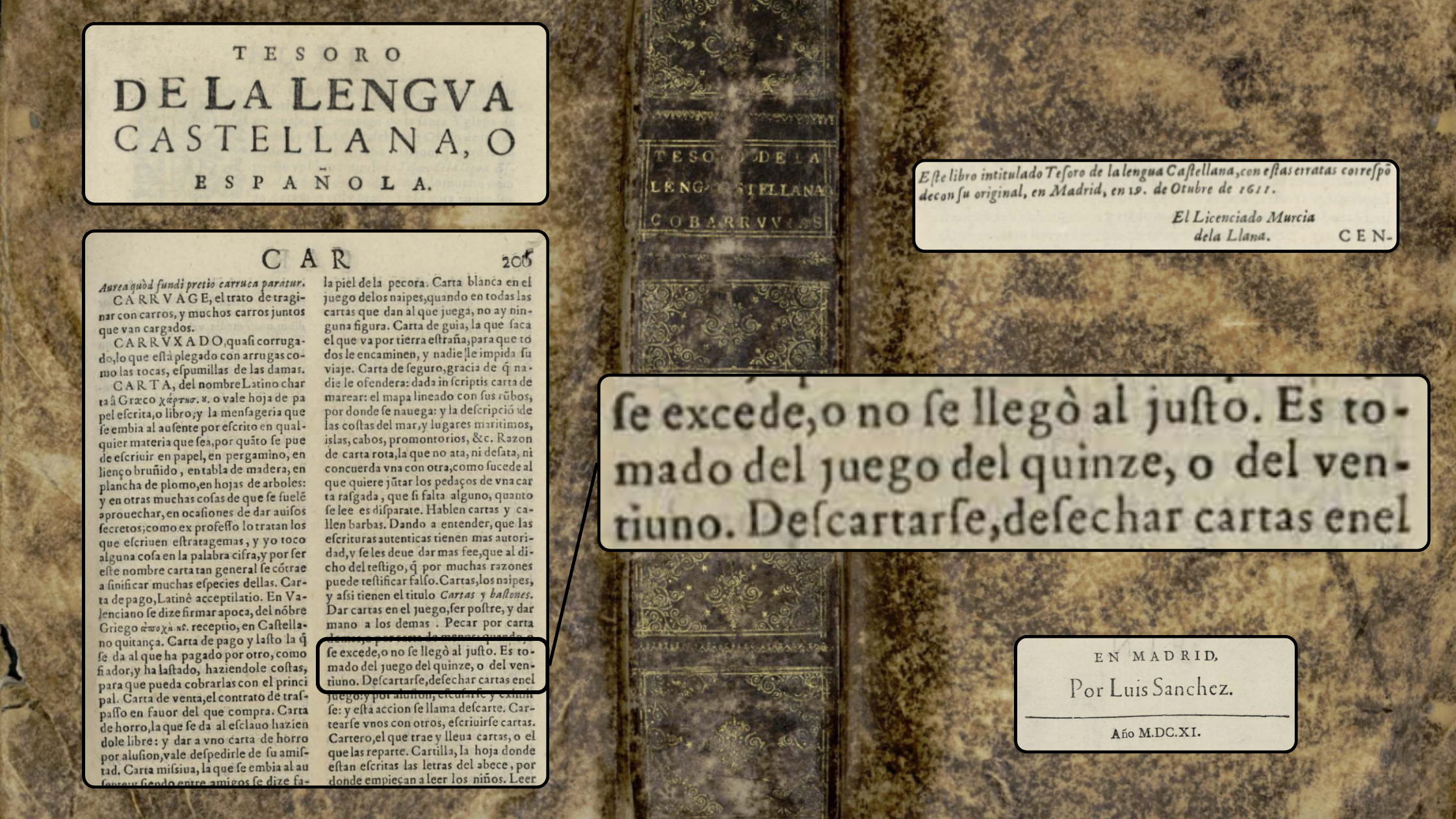
A couple of years later, the Spanish writer Miguel de Cervantes, most famous for writing Don Quixote, briefly described the game, including the two possible values taken by an ace, in his short story 'Rinconete y Cortadillo'.
"And if your worship is versed in this game, you will see how much advantage there is for someone who knows that he has an ace on the first card, which can serve as a point and as an eleven; for with this advantage, if the twenty-one is bet, the money stays at home."
The game made its way to Britain around the late 18th Century, with the rules first being laid out in 'Hoyle's Games Improved', from 1800, where it was called Vingt-Un.
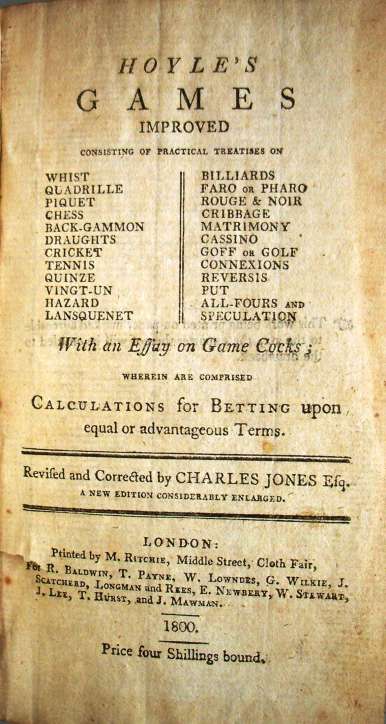
Vingt-Un was brought to the United States in the early 19th Century and renamed blackjack in 1899.
There's a popular and appealing myth that the name arose due to gambling houses in the US offering a bonus payout of 10:1 if the player was dealt an ace and a black jack (either the jack of clubs or the jack of spades).
However, it was actually prospectors in the Klondike Gold Rush who coined the name. Sphalerite, a mineral often found near gold and silver deposits, was known to miners as 'black-jack', and it's suggested by French card and games historian Thierry Depaulis that this name might have been transferred to describe the most valuable hand in blackjack, and the game itself.
The popularity and worldwide reach of blackjack have greatly increased since its early days, especially after the introduction of computerised and live blackjack tables at online casinos.
The Objective of Blackjack
In blackjack, players are playing against the dealer, rather than against each other. The basic aim of blackjack is easily described:
The goal of blackjack is to score more points than the dealer without going over 21.
How do you beat the dealer?
- By drawing a hand scoring more than the dealer's, without going over 21.
- If the dealer draws a hand scoring over 21. This is known as going bust.
- If your first two cards score a total of 21 points, which will always be an ace and a 10-scoring card (10, jack, queen, or king). This hand is called a natural, or blackjack.
How do you lose to the dealer?
- By scoring over 21 and going bust.
- If the dealer scores more than you at the end of the round, without going over 21.
Blackjack Card Values
In blackjack, each card has a points value. These are shown in the illustration below:
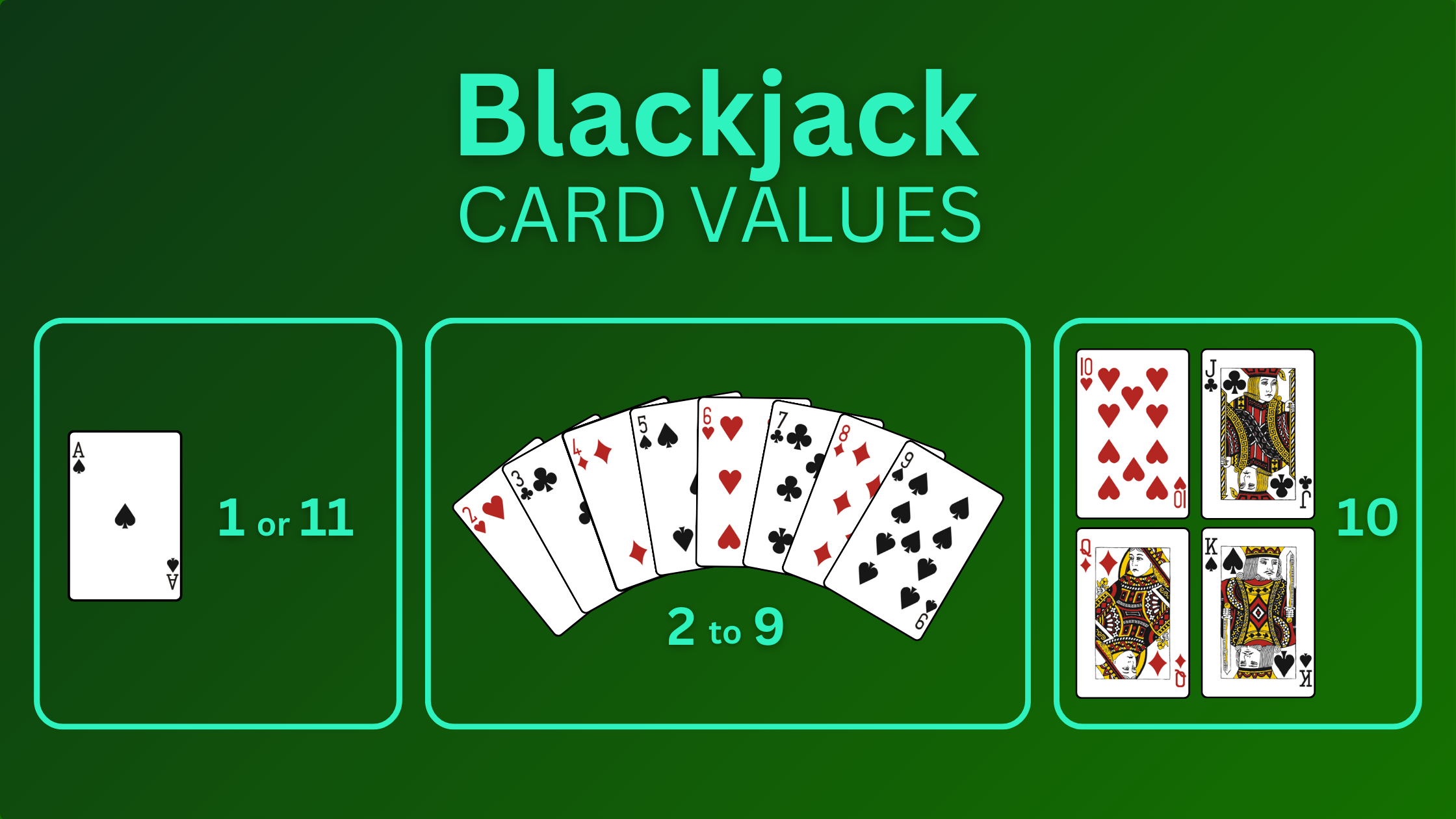
The card values are as follows:
- Numbered cards (2 to 10) are worth their face value.
- Face or court cards (jack, queen, and king) are worth 10 points.
- Aces are worth 1 or 11 points, whichever is best for the hand. Aces are sometimes described as flexible if they can be counted as either a 1 or 11 in the hand.
To work out the total points value of your hand, the individual card values are added together. This is straightforward for hands that don't contain aces, as you can see in these examples of hands that all total 20 points:
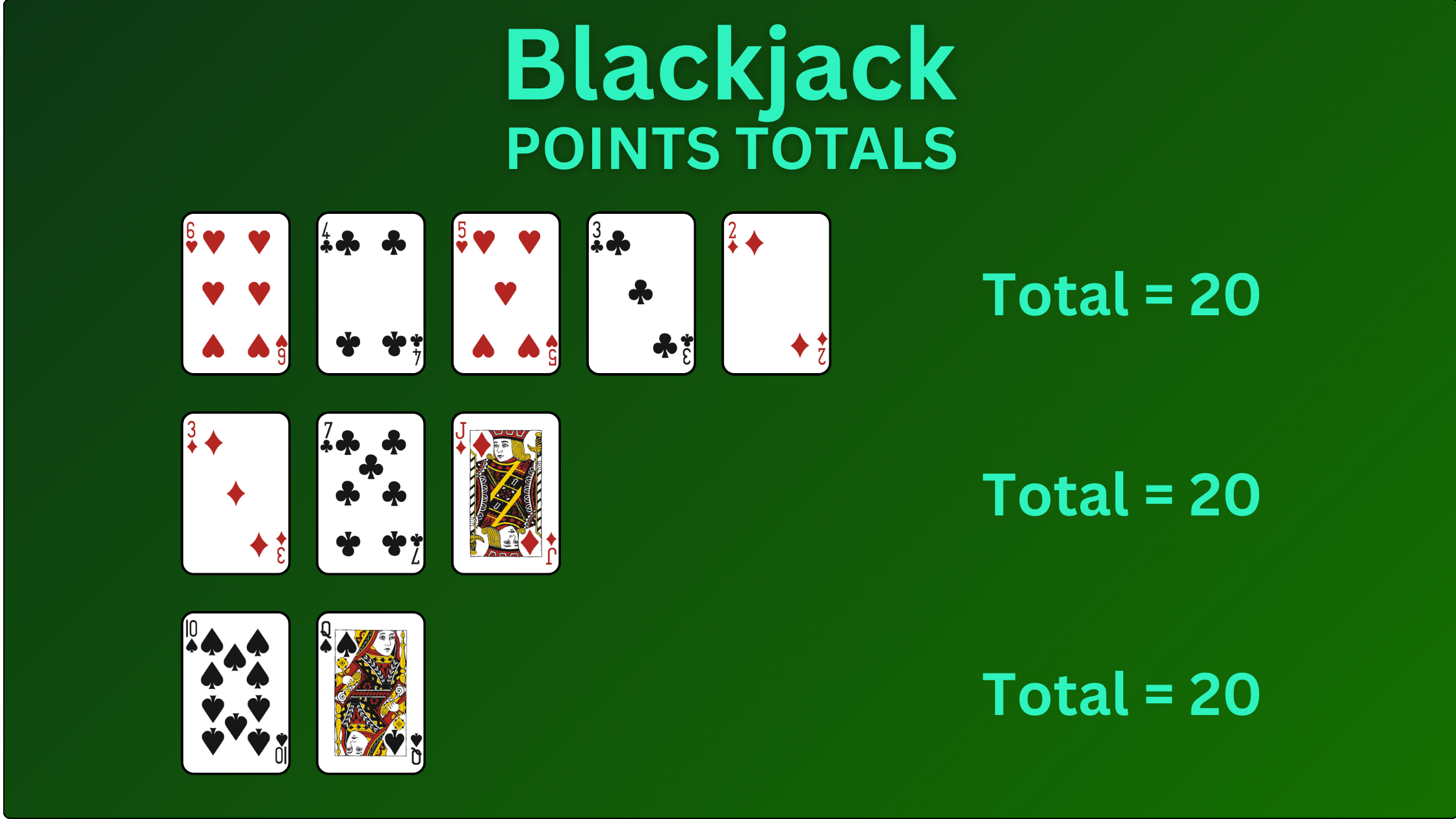
Soft and Hard Blackjack Hands
Despite the name, soft and hard hands in blackjack aren't related to your level of hand lotion use, but arise due to the flexible nature of aces (namely that they can score either 1 or 11 points).
What is a Hard Hand?
A hard hand is any hand that does not include a flexible ace.
A flexible ace is an ace that can score either 1 or 11 points in your hand. All cards without an ace are hard hands, as are hands with an ace that must score 1 to avoid the hand busting.
Here are some examples of hard hands:
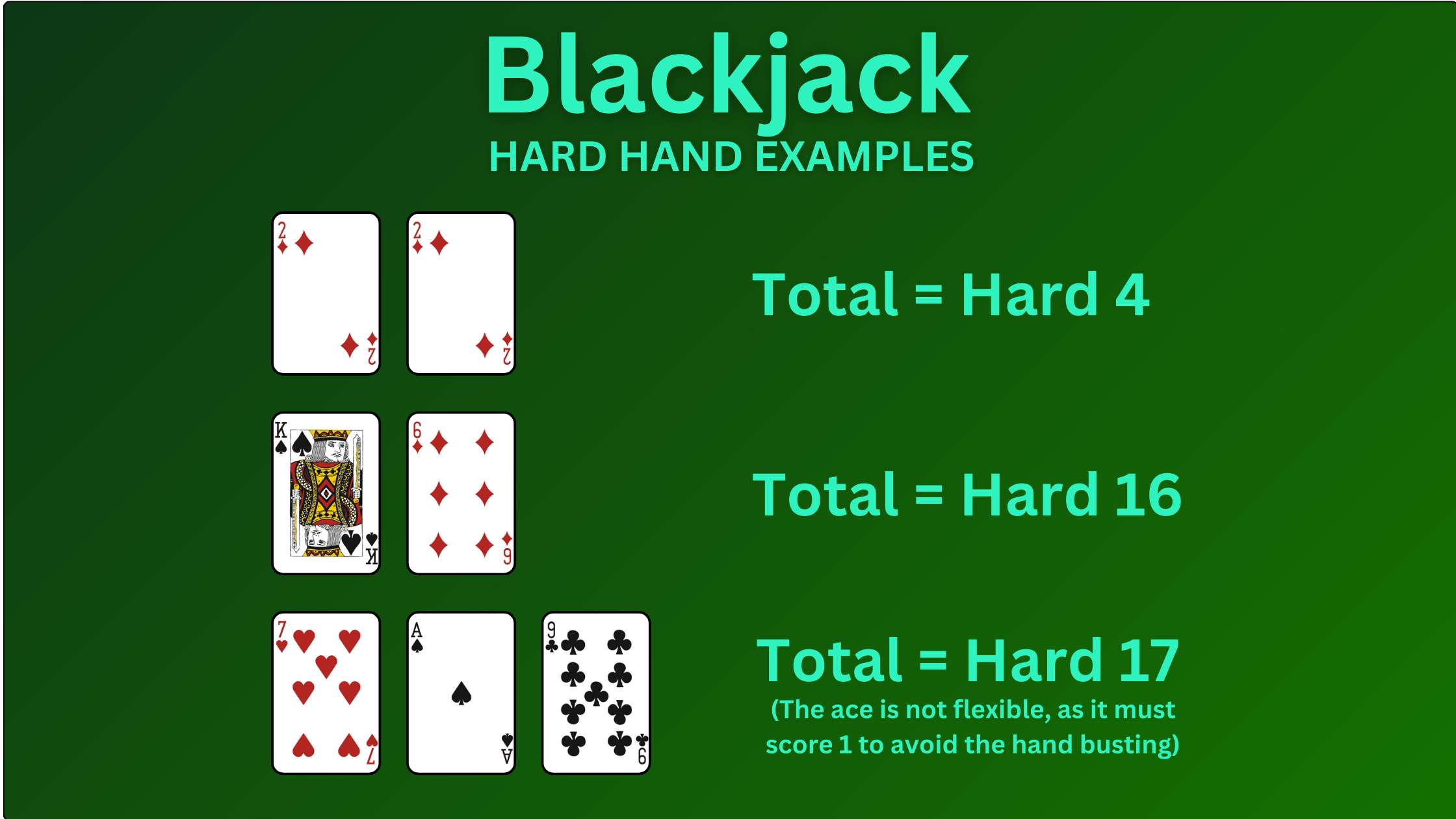
What is a Soft Hand?
A soft hand is any hand that includes a flexible ace and that can't bust if you're dealt another card.
If your hand contains a flexible ace (i.e. one that can score either 1 or 11 in your hand without you going bust), you can choose whether this scores 1 point or 11 points.
You should always decide based on which option is most favourable to your hand. Fortunately, Basic Blackjack Strategy, which we'll cover shortly, takes the guesswork out of this.
Soft hands are always named by the higher of the possible totals. Here are some examples:
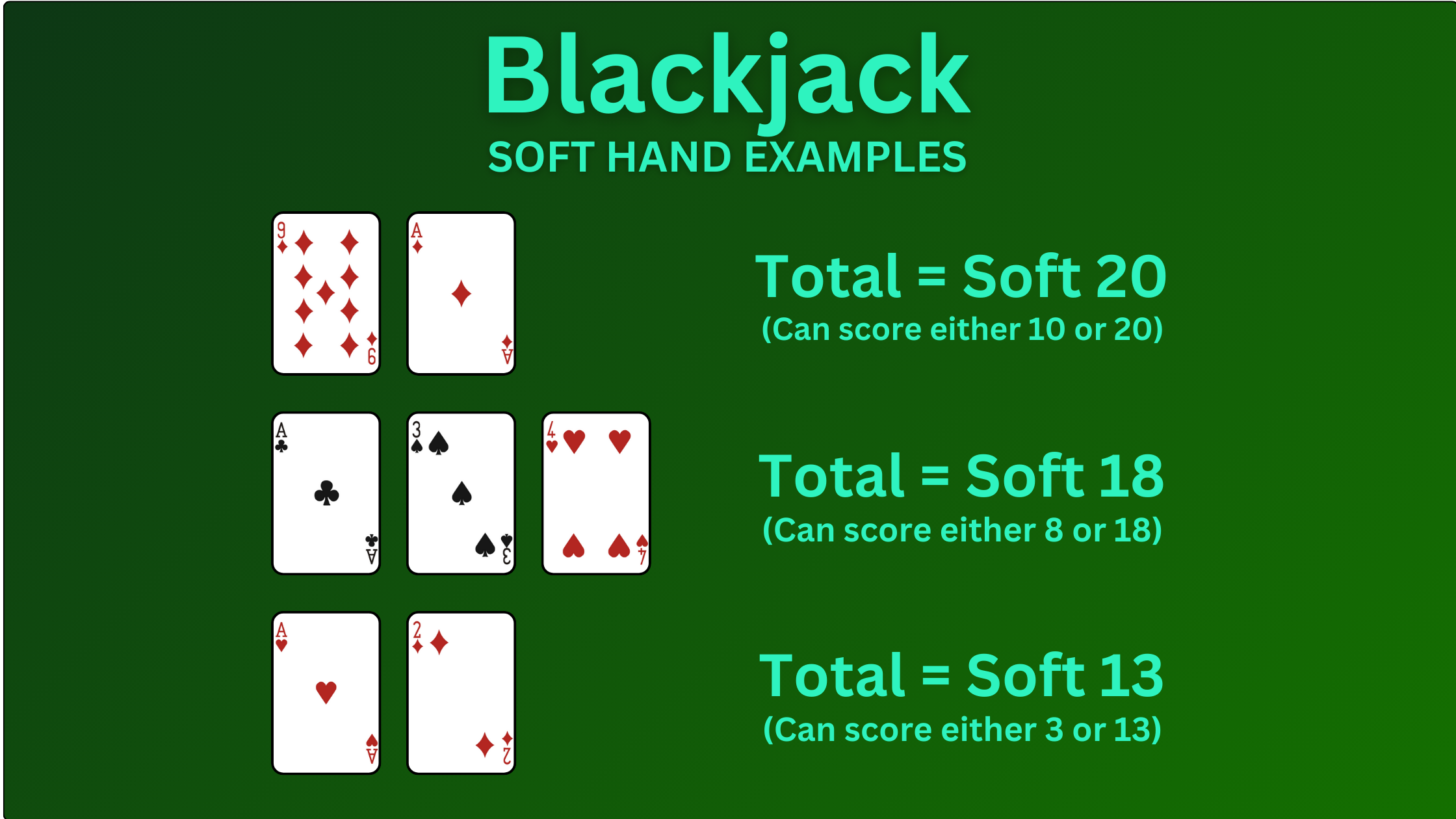
Blackjack Table Layout
Blackjack tables are usually semi-circular, with the dealer at the straight edge behind the chip rack and players seated opposite, around the curved edge.
A typical blackjack table is shown below. Although this one is from a computerised version of blackjack, it's a pretty accurate representation of real blackjack tables.

The different parts of the table are labelled below:
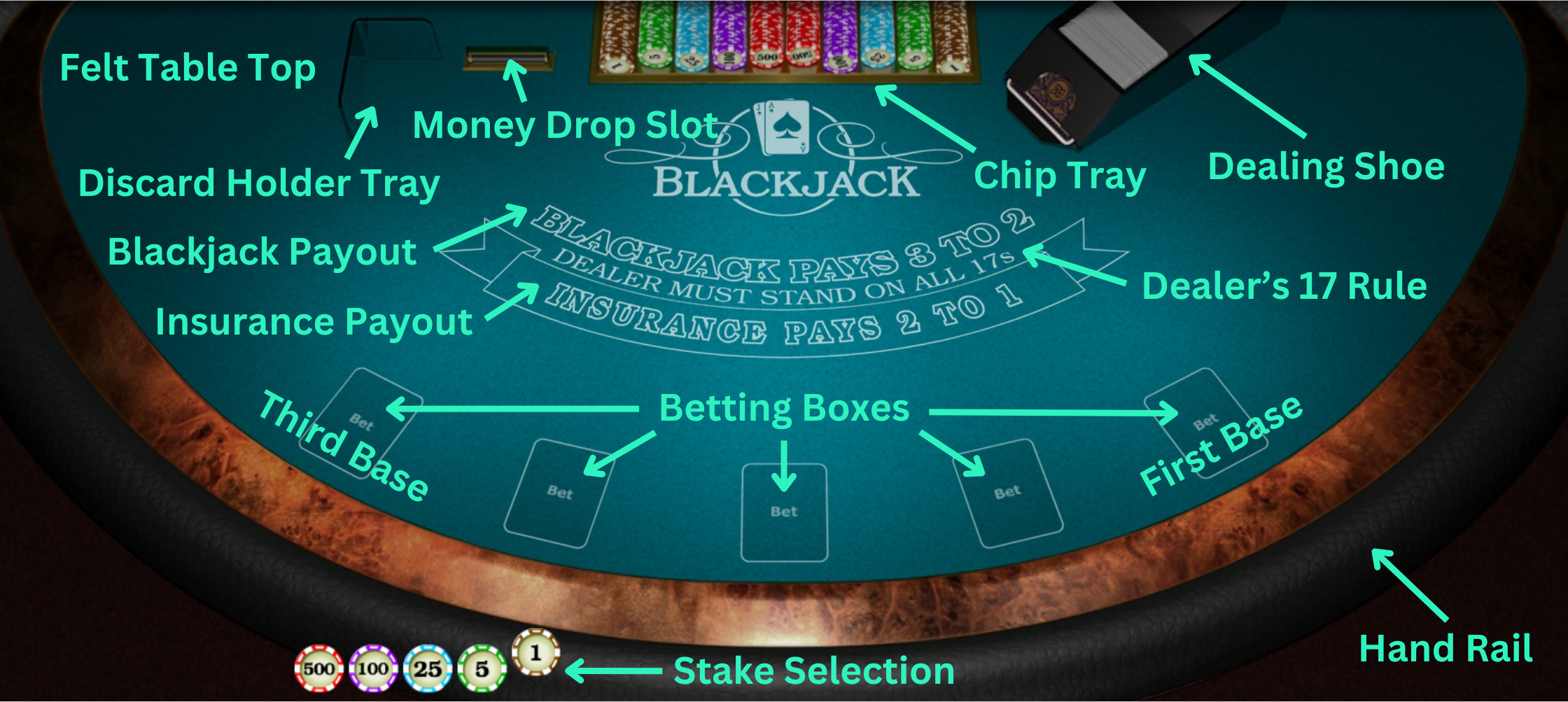
Here's a brief desription of the different parts:
- Felt Table Top - This is often green, but other colours are frequently used.
- Money Drop Slot - The Dealer puts currency from players into this slot and converts this to casino chips. The slot leads to the secure Casino Drop Box beneath.
- Discard Holder Tray - After a round has finished, the dealer stacks the used cards horizontally here.
- Blackjack Payout - This shows the rule for how players are paid out if they win with a blackjack. The standard payout is 3:2, but some casinos have introduced the much worse 6:5 payout (you should avoid playing at these tables).
- Insurance Payout - The rule for insurance payouts is shown here. This is almost always a 2:1 payout.
- Betting Boxes - Players can place their stakes in one or more betting boxes, adding their chosen number of chips to them. In physical casinos, cards are dealt in front of these (from the point of view of the player), whereas in computerised blackjack, the cards are often dealt on top of the betting box, covering the chips. The places where the players sit are called spots, and there are generally 7 of these, although they can range from 5 all the way up to 12 in extreme cases.
- Stake Selection - In online blackjack, this is where you select how many chips you want to stake.
- Hand Rail - This gives players something comfortable to lean on whilst protecting the table.
- Dealer's 17 Rule - This section describes whether the dealer must hit or stand if they're dealt a soft 17.
- Dealing Shoe / Sabot - Cards are held here before being dealt. Various numbers of decks, from 1 to 8, are used, with 4-8 being most common. If multiple decks are used, they're shuffled together. The dealer draws cards by sliding one card at a time from the front of the shoe.
- Chip Tray - The casino's supply of chips with various values is kept here.
- First Base - This is the spot immediately to the left of the dealer, where the first hand is dealt to.
- Third Base - This is the furthest spot from the dealer, and the last one to be dealt a hand.
- Hole Card Reader - This isn't shown in the image, but it's a device that allows the dealer to securely check for blackjack.
Order of Play
Whilst there are many variants of blackjack, they all tend to follow the same order of play. For blackjack at real world casinos, this goes as follows:
- Buying Chips.
- Placing Wagers.
- Dealing Cards.
- Players Play Their Hands.
- The Dealer Plays Their Hand.
- Bet Settlement.
Buying Chips
Since you can't usually play blackjack using cash at casinos, you first need to exchange your cash for casino chips, which are bought from the dealer.
To buy them, place your money just outside your betting box and let the dealer know the denominations of chips you want.
Dealers aren't allowed to take cash directly from players, or hand it to them, to prevent collusion between the dealer and player.
Once the cash is on the table, the dealer lays it out to make it clearly visible to the cameras, and a pit boss will verify the amount of money exchanged.
After the dealer has counted the chips and placed them on the felt of the table, you can take them, stack them in front of you, and place your wager.
Placing Wagers
At the start of a blackjack round, you first place a wager in the betting box.
The dealer will open the bets by moving their hand in an arc, palm-up, from first to third base, over the betting rules.
The betting limits, telling you the minimum and maximum stake for wagers, should be shown on a sign on either the far left or far right of the table. If you use chips with different values, you should stack them with the lower values at the top.
Once all players have placed wagers, the dealer closes the bets by moving their hand palm-down from third to first base.
You now aren't allowed to touch your chips. Chips also shouldn't ever be passed directly to the dealer or taken directly from them.
Dealing the Cards
The dealer deals one face-up card to each player in a clockwise direction, before dealing themselves a face-down card.
The face-down card is known as the dealer's hole card. One more face-up card is then dealt to each player, then a face-up card is dealt to the dealer.
You can see what this initial deal looks like in this screenshot of Premium Blackjack, a popular online version of the game (in blackjack in an actual casino, the dealer's hole card is often underneath their face-up card):
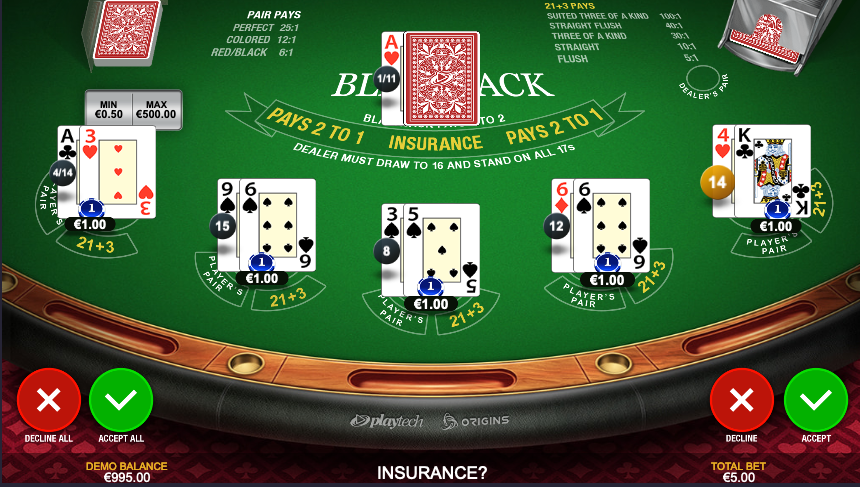
It's worth mentioning that not all blackjack dealers deal their first card face-down. Some deal the first card face-up and the second face-down.
An alternative version of blackjack, popular in Europe, called European No Hole Card Blackjack or just European Blackjack, has no hole card at all.
Here, the dealer only deals themselves a single card initially, and only deals a second card to their hand after the players have played their hands.
It's important to avoid touching your your cards at any point whilst playing. There's no need to touch the cards, and doing so is against casino rules.
Playing the Hands
Starting from the player immediately to the dealer's left (first base) and moving in a clockwise direction to the final player on the dealer's right (third base), players decide how to play their hands. If the dealer's face-up card is an ace or 10-value card, and there isn't a no-peek rule, they'll check their hole card to see if they have blackjack (an ace and a 10-value card).
Specialised Peek Decks and Hole Card Readers
To avoid having to lift the hole card from the table to check for blackjack, which risks players seeing it, casinos tend to use a hole card reader (also known by various other names, including blackjack peeker).
These are devices with a mirror that reflects the corner of the downwards-facing hole card through a small viewing window, with the dealer having a small field of view to see the reflection.
Specialised peek decks are used that have the indices (the symbols in the corners) in different places depending on whether the cards are number cards, 10-value cards or aces. Here's an example of a peek deck:
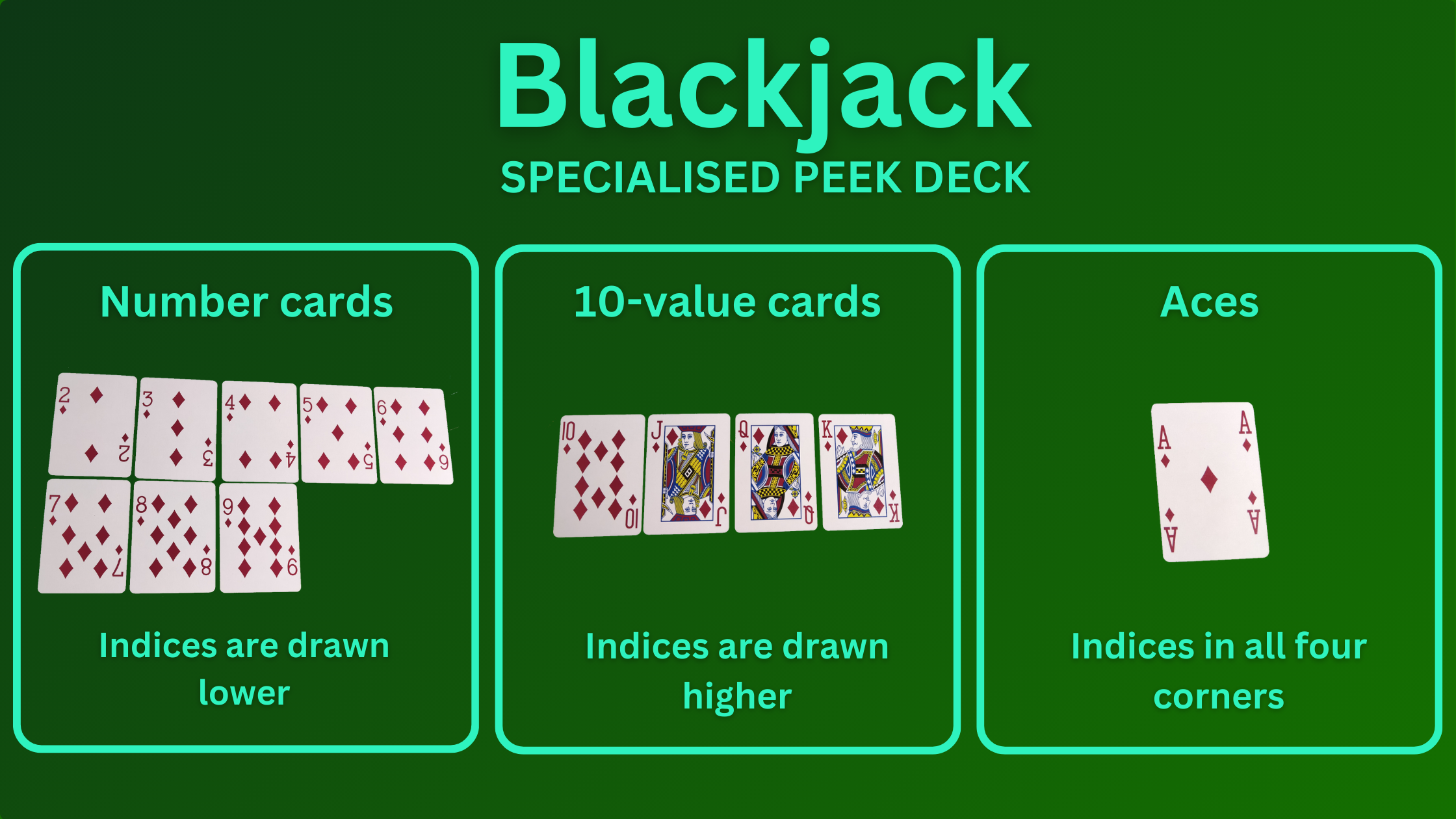
If the dealer's up-card is a 10-value card, they insert the corner of the card into the hold card reader upright. If the upcard is an ace, they insert it sideways.
If they don't see anything through the viewing window, they know that they don't have blackjack, but if they see any markings at all, this tells them that they have blackjack.
The beauty of using a specialised peek deck in conjunction with a hole card reader is that the dealer doesn't need to bend up the corner of the hole card to check for blackjack, which could lead to them inadvertently, or deliberately, showing the value of the card to players behind them.
If the dealer has a blackjack, the round ends immediately, with all players losing their stakes unless they have a blackjack as well, which results in a push, or if they took a side bet called insurance (discussed later).
If the dealer doesn't have blackjack, the hole card peeker just shows white through the viewing window, so the dealer doesn't know the value of the hole card.
This prevents any possible collusion between the dealer and players, which adds a layer of security to the game.
Some hole card readers have an electronic sensor rather than a mirror, and signal the presence of blackjack by lighting up an LED.

If the dealer isn't dealt blackjack, play will proceed. The player at first base chooses how to play their cards first. Any players dealt blackjack won't receive any further cards, and will win their wager (usually a 3:2 payout, as will be covered later).
We'll look at the optimum way to play blackjack shortly. First, though, here's a quick summary of the different options available to players. Most real-life casinos require you to use hand gestures to signify how you want to play, rather than speaking to the dealer. The exception is if you choose to surrender.
Hit
If you want to request another card to try to improve your hand, you hit. There's no limit to the number of times you can hit, although you won't receive any further cards if you end up with either a soft or hard 21 (since this is the highest score you can achieve without going bust, so you can't improve your hand with further cards). To signal you want to hit, tap the table once or twice with either your index finger or index and middle fingers held together, and you'll be dealt another face-up card.
Stand
If you're happy with your hand and don't want any more cards, you signal that you want to stand. To show this, hold or wave your hand over the table, palm down, with your fingers together.
Split
If you're dealt a pair (two cards with the same value, like two 8's), you have the option to split. To signal this, first place the same amount of chips already staked next to your current chips, to double your stake. Then, with your palm downwards, separate your index and middle fingers into a V-shape and place the fingertips of these fingers on the table.
If you have two 10-value cards like a 10 and a jack, you are allowed to split these, even though they aren't the same card. As we'll see later though, unless you're card counting, you should never split 10s.
The dealer will split the two cards by moving them side-by-side, making two hands, then deal another face-up card onto each card.
Unless the cards that you split were aces, you'll then be able to hit either of your hands and, depending on the rules of the game, in some cases, double or split again (known as re-splitting). Each of your split hands is treated as an individual hand.
Double / Double Down
First, add the same value in chips already staked to the side of your current stake. Then, place your extended index finger on the table to signify you want one more card (you only get dealt one additional card if you double). The dealer will deal this card face-up and sideways onto your hand, to show that you aren't allowed any more cards. If your hand wins, you receive double your original stake in profit. If your hand loses, you lose double your original stake.
Surrender
Clearly say "surrender" to the dealer, then slide the tip of your index finger horizontally across the table, beneath your bet, as if you're cutting through the cloth. This is the only case where you speak to the dealer to explain how you want to play your hand. When you surrender, you immediately lose the hand, but get half of your stake back.
Surrendering isn't always allowed in blackjack games and, when it is, it's only worth taking in certain specific cases, where your hand is very weak compared to the dealer's up-card. Basic Blackjack Strategy, covered later, tells you when you should surrender.
Insurance
Insurance isn't part of the main game of blackjack, but is a very common side bet normally offered by casinos. With insurance, you're betting that the dealer has blackjack. If the dealer is dealt an ace, the players are asked if they want to take insurance against the possibility of the dealer being dealt blackjack.
When you buy insurance, you add half of your stake to your wager, placing it in the insurance section of the table. Your insurance bet wins if the dealer has blackjack and loses if they don't. There are then three possibilities:
- The dealer has blackjack - you lose your main bet but make twice your insurance stake in profit. If your stake is £1, your insurance bet will be 50p. This means you'll lose your £1 main bet stake but make a profit of £1 on your winning insurance bet, and you'll break even.
- The dealer doesn't have blackjack and your main bet wins - As long as you haven't doubled or split, you'll make a profit equal to your original stake but lose your insurance bet (half your stake), so your overall profit will be half your original stake.
- The dealer doesn't have blackjack and your main bet loses - You'll lose both your main and insurance wagers. Assuming you haven't doubled or split, this will be a loss of 1.5 times your original stake.
The hand you're dealt is completely irrelevant when dediding if you should take insurance - you're betting on whether or not the dealer has blackjack, and your hand doesn't affect the likelihood of this at all. In terms of playing blackjack the optimum way, using Basic Blackjack Strategy, the rule for whether or not to take insurance is really simple - never take insurance!
The only time to take insurance is if you're card counting using the Hi-Lo Method and the true count is +3 or greater, in which case you should always take insurance.
With regards to other side bets (whether that's Perfect Pair, 21+3, or any number of other options), a general rule of thumb is that none of them are worth taking from a value perspective - they only serve to increase the house edge and reduce your Return to Player. It's best to think of them as an interesting option that some gamblers enjoy betting on.
Insurance and Even Money
Insurance in blackjack is often called a 'sucker bet', since taking it only serves to increase the house edge. Some casinos offer a side bet called Even Money, also costing half the original stake, which they offer to players who are dealt a blackjack when the dealer is showing an ace. On tables that have a 3:2 payout on blackjack, even money bets are mathematically identical to insurance bets, and should be treated in the same way (i.e. never taken unless you're card counting).
Blackjack Hand Gestures
Below you can see a summary of the different blackjack hand gestures:
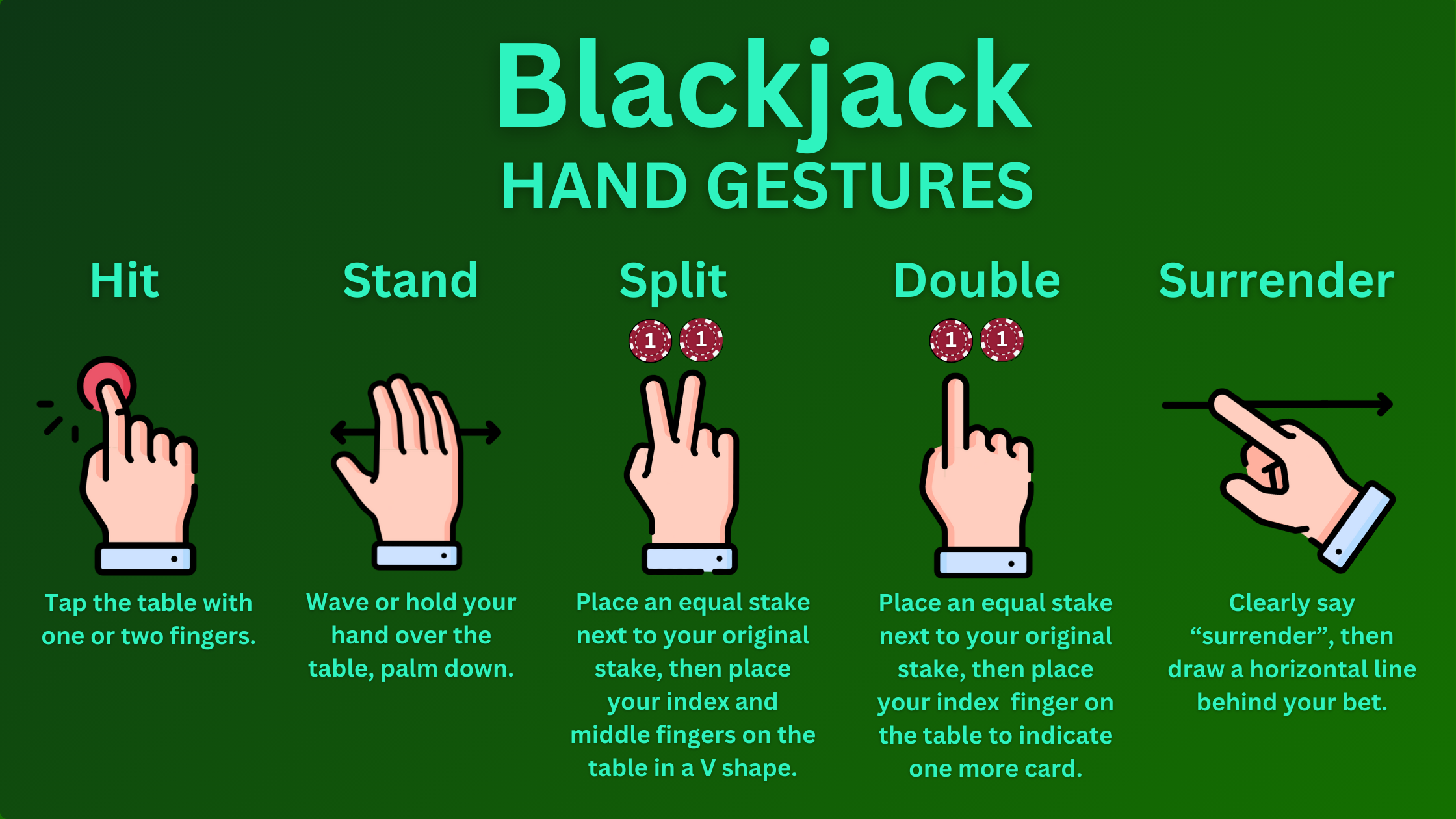
How the Dealer Plays Their Hand
Once all players have played their hands, the dealer plays their hand. With no-peek blackjack variants, the dealer either has a hole card but doesn't check for blackjack before the players play their hands, or doesn't have a hole card at all (European Blackjack).
For blackjack variants where the dealer peeks for blackjack, they will check for a blackjack before the players play their hands and turn over their hole card if they do have blackjack.
If this happens, any players who don't also have blackjack immediately lose the hand. The no-peek rule gives the casino a slightly larger edge, since players might have doubled or split before the dealer revealed they had blackjack, leading them to lose more than a single stake. In contrast, with blackjack variants where the dealer peeks, it's only possible for the player to use their initial stake, since they will already have lost the hand before having the option to double or split.
Before the dealer turns over or deals their second card, these are the different scenarios for a player's hand:
- Blackjack was dealt and the hand has already won.
- The hand has a total point score of 21 or under and is still in play.
- The total point score of the hand was over 21, and the hand has bust and is out of play.
The fact that players play their hands before the dealer, and can therefore bust before the dealer has played, is the reason the casino has an edge (advantage) over the player. The options given to the players to double, split, or surrender, as well as the 3:2 payout on blackjack, reduce some of the house edge (the casino's advantage) due to the dealer playing last, but can't overcome it completely. Therefore, unless you're card counting or using some other advantage gambling strategy, like peeking the hole card, the Return To Player (RTP) of blackjack is less than 100%, even if you play with perfect Basic Blackjack Strategy. We'll look at blackjack RTP and the Basic Blackjack Strategy shortly.
Assuming the player's hand is still in play, the dealer reveals their second card and adds up their total score. The dealer has no choice in how they play their hand, and the way they play it is governed by the house rules of the blackjack variant the're playing.
In all cases, the dealer must hit if their total points value is 16 or less. If they have 18 or above, whether it's a hard or soft hand, they must always stand.
Dealers can only hit or stand, and aren't allowed to double, split or surrender.
If the dealer has a hard 17, the dealer must also stand. However, if their first two cards are an ace and a six (a soft 17), whether they have to hit or stand depends on the rules of the casino. The rule should be clearly labelled on the felt tabletop, for example "Dealer must draw to 16 and stand on all 17s" or "Dealer hits on soft 17".
If the dealer hits on soft 17, this gives them more of an advantage over the player, compared to if they stand on all 17s, since the dealer has a chance to end up with a higher points score than 17.
In online blackjack games, all the rules will always be available and linked directly from the game itself. With real-world casinos, rules that aren't clearly shown on the felt might be shown in writing. If they aren't, you should be able to ask the dealer about them.
Bet Settlement
Once the hands of both the players and dealers have been played, it's time for the bets to be settled. Here are the possible outcomes for your hand, although as mentioned, no-one but card counters should take insurance, so you can probably ignore 8-11:
- Win With More Points Than the Dealer - You win by scoring more points than the dealer, without going bust. Your profit will be equal to your stake.
- Win Because the Dealer Busts - You win because your hand is still in play and the dealer goes bust. Again, your profit will be equal to your stake.
- Win With Blackjack - Your first two cards were an ace and a 10-value card (a blackjack) and the dealer didn't also get blackjack. Normally, blackjack is paid out at 3:2, meaning your profit will be one and a half times your stake.
- Push - Your score is tied with the dealer's and you get your stake back, so you'll break even. This also applies if both you and the dealer are dealt blackjack.
- Lose With Fewer Points Than the Dealer - If the dealer's hand scores more points than yours, without going over 21, you'll lose your stake.
- Lose Because Your Hand Busts - If your hand busts, you also lose your stake. It doesn't matter if the dealer also busts, since you lose your wager instantly when you go bust, and before the dealer plays.
- Surrender - If you surrender, you instantly forfeit your hand but get half your stake back. Your overall loss will be half your original stake.
- Winning Insurance Bet - If you took insurance and the dealer is dealt blackjack, your insurance bet (half your main stake) wins and returns twice the insurance stake as profit. You'll also lose your original stake. Assuming you haven't doubled or split, and that you don't have blackjack yourself, you'll break even.
- Winning Insurance Bet When You Have Blackjack - If you take insurance after being dealt blackjack, and the dealer also has blackjack, you'll win your insurance bet, which will be a profit equal to your original stake. Your main bet will be settled as a push, so you won't lose your original stake. Your profit will be equal to your original stake.
- Losing Insurance Bet and Winning Main Bet - If you take insurance, the dealer doesn't have blackjack, and your main bet wins, you'll lose your insurance bet (half your stake) and win your main bet (your original stake). Overall, your profit will be half your original stake.
- Losing Insurance Bet and Losing Main Bet - If you take insurance, the dealer doesn't have blackjack, and your main bet loses, you'll lose your insurance bet (half your stake) and also lose your main bet (your original stake). Overall, your loss will be one and a half times your original stake.
1. Win With More Points Than the Dealer

2. Win Because the Dealer Busts

3. Win With Blackjack
If you or the dealer are dealt an ace and a 10-value card (10, jack, queen, or king), this is called a blackjack or natural.

4. Push

5. Lose With Fewer Points Than the Dealer

6. Lose Because Your Hand Busts
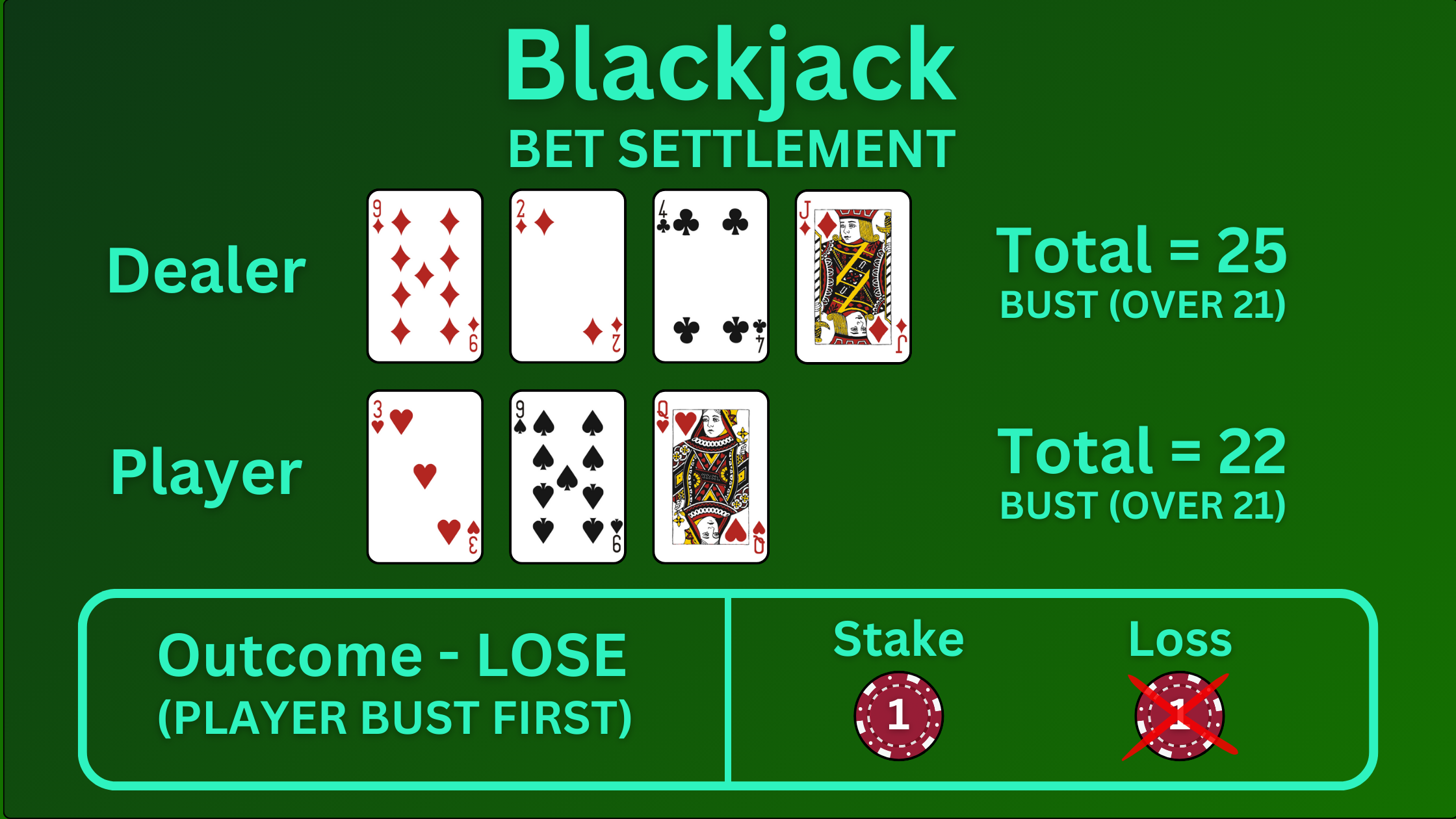
7. Surrender
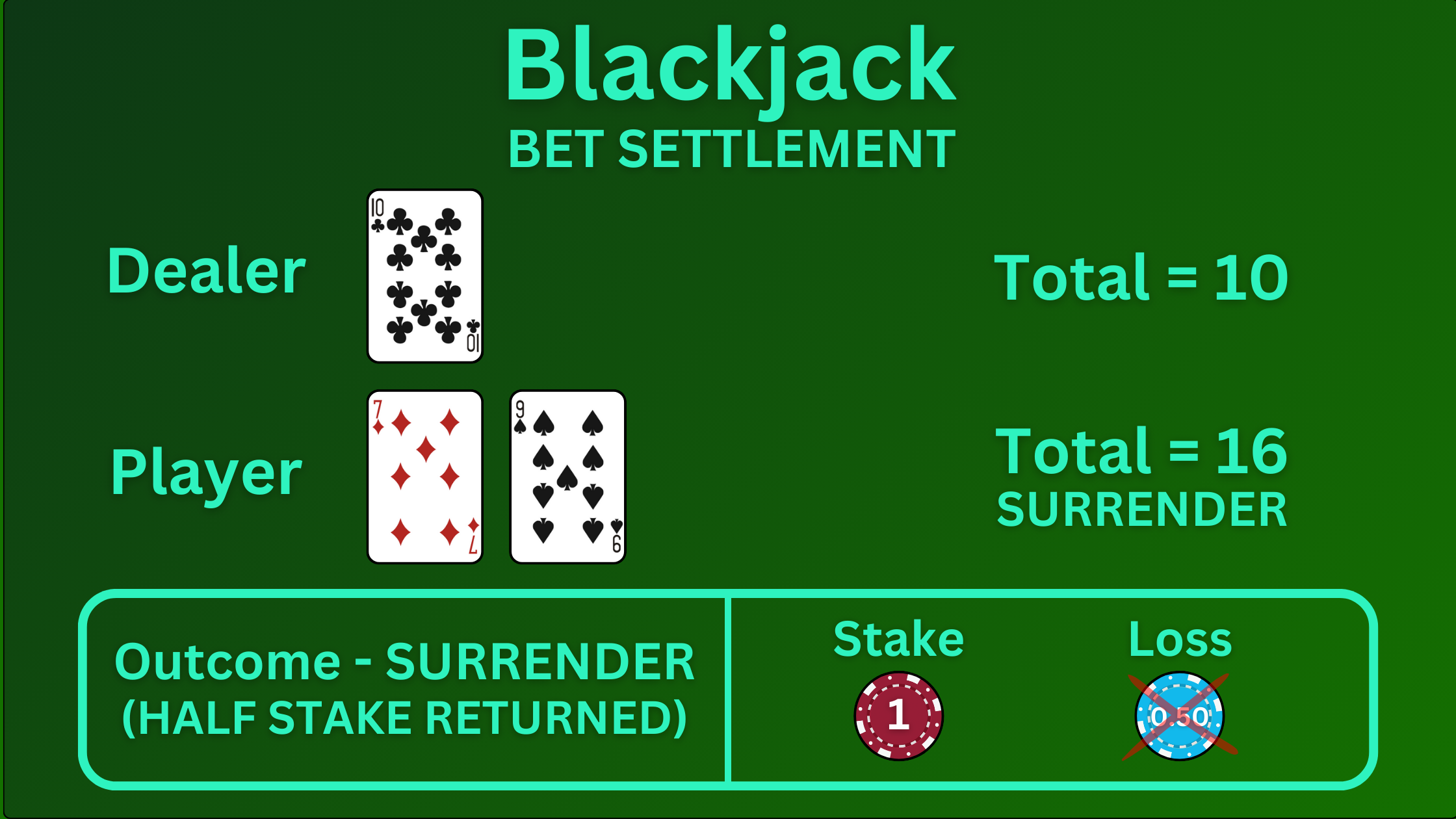
8. Winning Insurance Bet
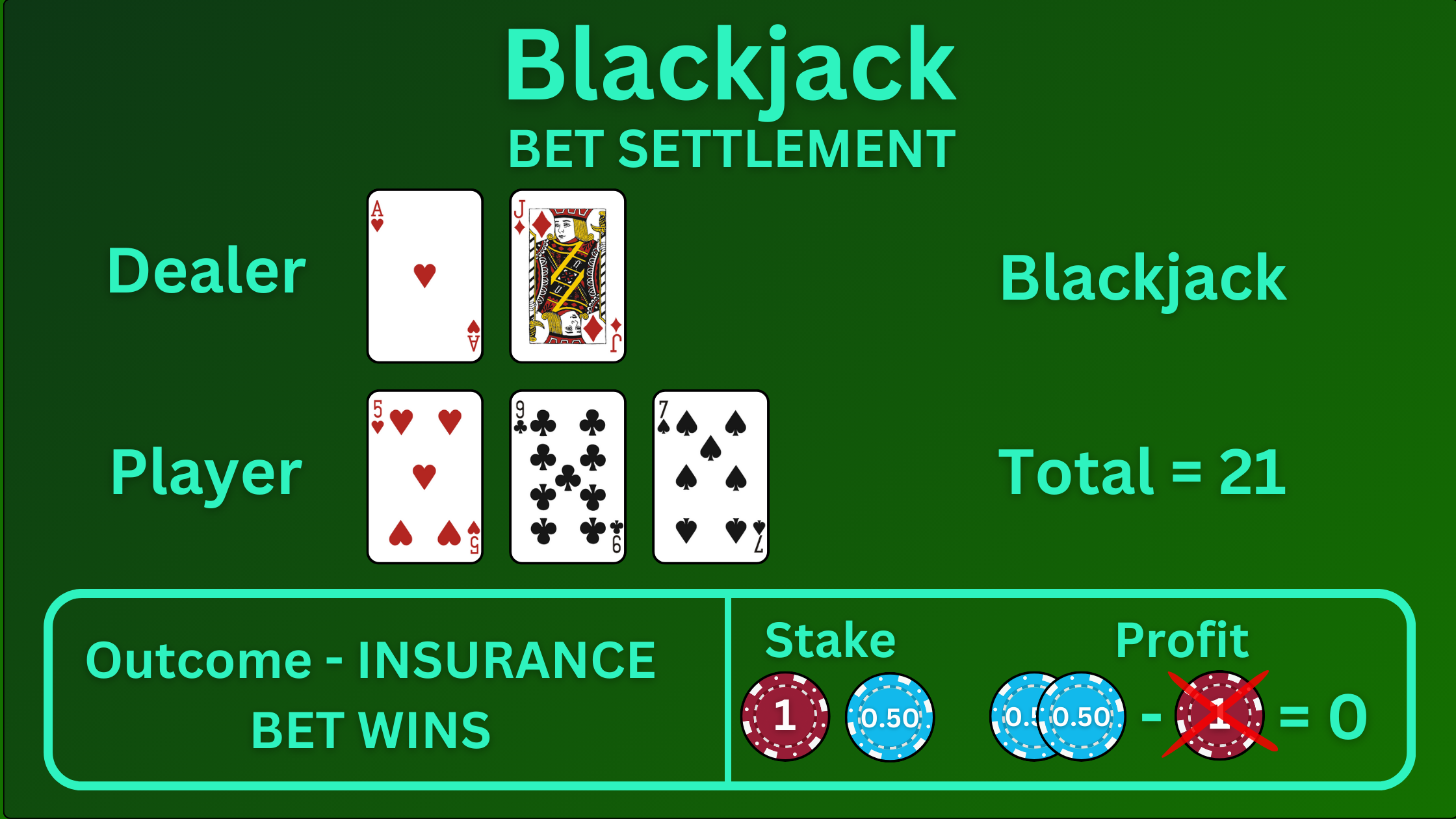
9. Winning Insurance Bet When You Have Blackjack
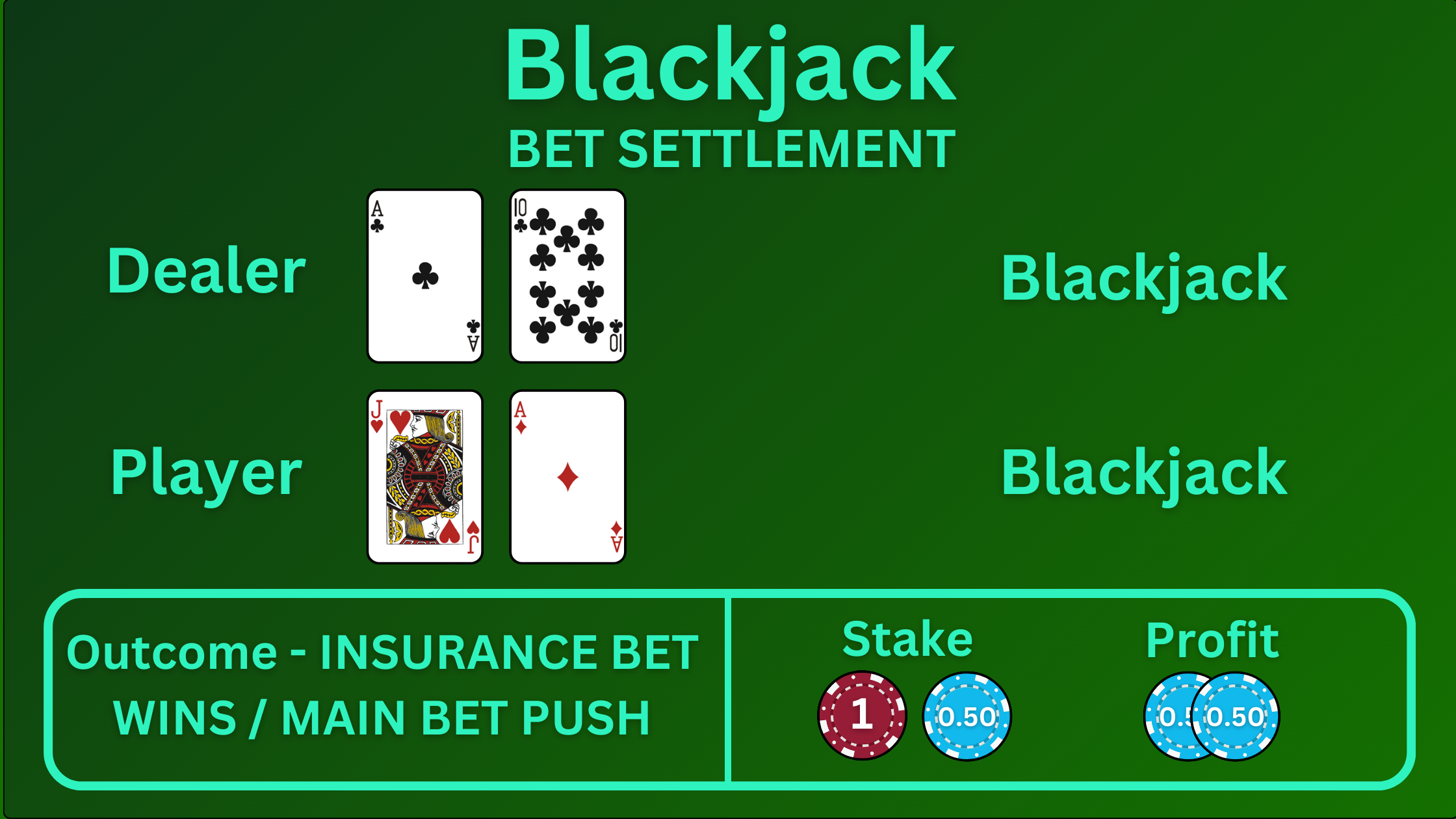
10. Losing Insurance Bet and Winning Main Bet
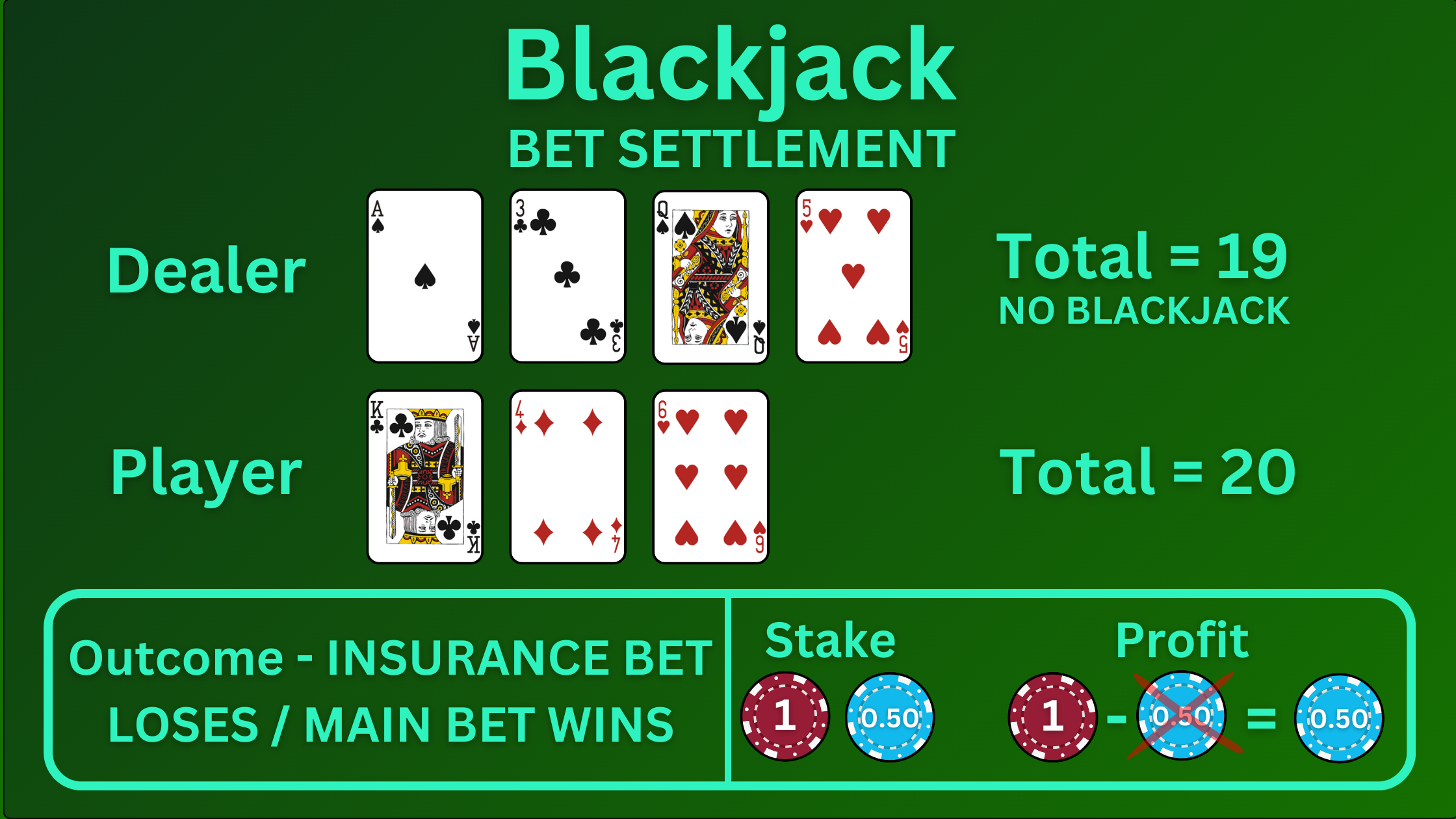
11. Losing Insurance Bet and Losing Main Bet
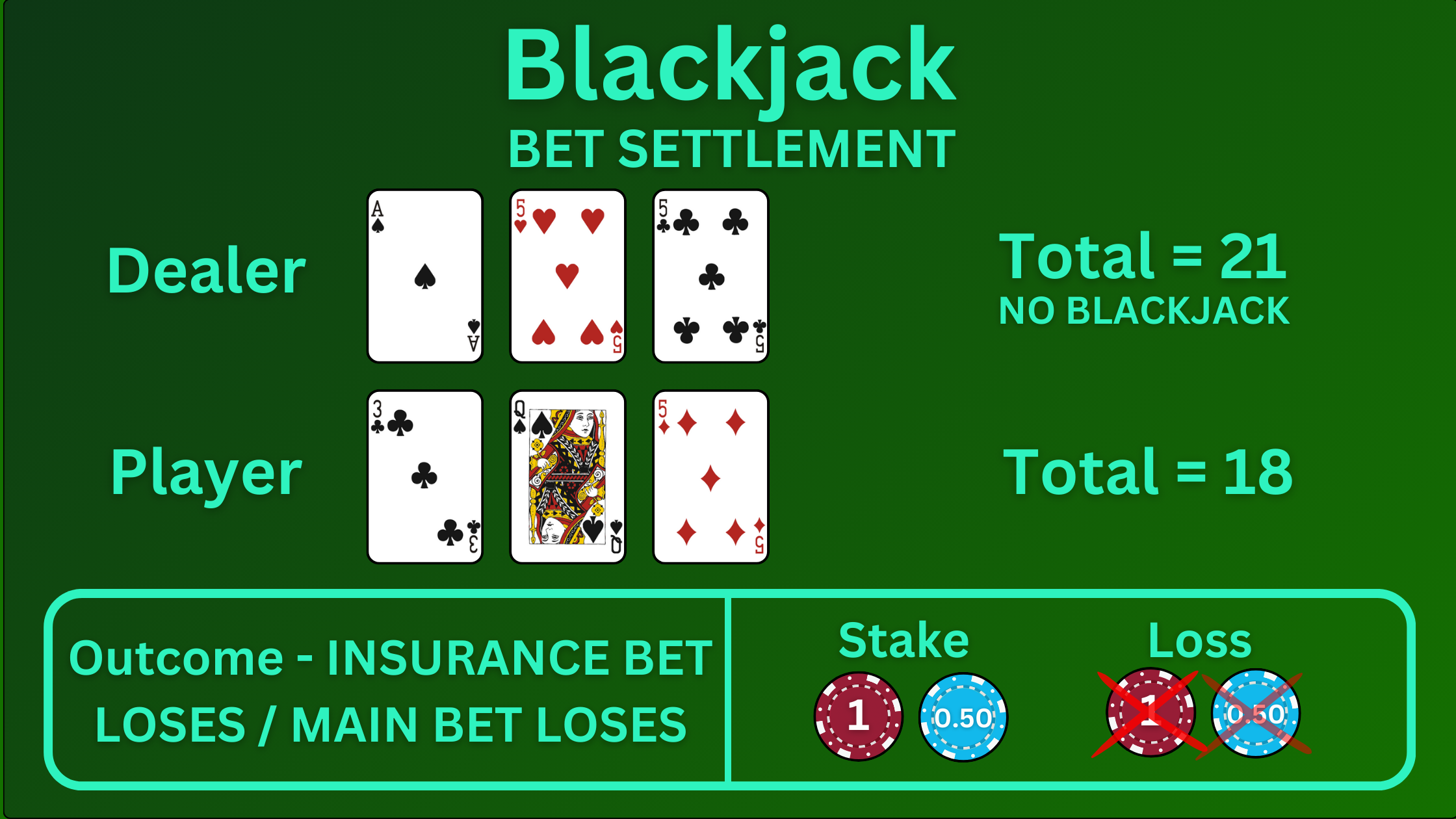
Early Blackjack Strategy
Blackjack is a skill-based game, where the strategy you use affects the house edge and the related Return To Player (RTP). Although the rules are simple to understand and the game straightforward to play, the best strategy to maximise your RTP and reduce the house edge is far from obvious. Before the 1950s, the best a player could do was rely on a combination of experience and intuition, or read advice or strategies published by card experts, when deciding how to play.
Sometimes, the best way to play is obvious - for example, you should never stand if your hand is worth 11 or less. There's no way you can bust in this scenario, and hitting can only make your hand better (doubling or splitting will be even better in certain circumstances). However, most of the time, it's much less clear how you should play your hand.
An example of early blackjack strategy was published in 1952 in 'Culbertson's Card Games Complete' by Ely Culbertson, a prominent contract bridge player and writer. In the book, he outlined his "pointers for play" for blackjack, which included sound advice like always standing on hard 17, always splitting aces and never splitting tens or 5s. It also included advice now known to be inaccurate, for example suggesting that it's probably best to always avoid splitting unless you have a pair of aces. The book also states that estimates of the house edge in blackjack at the time were between 7.5% and 10%. However, he noted that this was disputed, with some experts suggesting a much smaller dealer advantage (they were right - the house edge is around 0.5% if you play the optimum strategy). The reason for this uncertainty was spelled out in the book:
In no game that has been played for high stakes over so many years has there been less analysis of the science of play than in Vingt-et-Un. The only available guide to strategy is empirical; no one has more than his opinion on which to estimate the opinion of the dealer.
Basic Blackjack Strategy
Blackjack strategy was revolutionised in September 1956 when The Optimum Strategy in Blackjack, written by Roger Baldwin, Wilbert Cantey, Herbert Maisel, and James McDermott was published in the Journal of the American Statistical Association. This was the first published attempt to analyse blackjack mathematically. The authors, dubbed the 'Four Horsemen of the Apocalypse' or 'Four Horsemen of Aberdeen', were four mathematically minded army engineers who used equations, probability, and statistics to formulate an effective strategy, which formed the basis of the Basic Blackjack Strategy used today. They also made a very good estimate of the true house edge, at 0.62%. Wilbert Cantey later said that there was an error, and this should have been listed as 0.32%, and Ed Thorp calculated that the published strategy actually gave the player an edge of 0.09%.
In 1957, they included their work in 'Playing Blackjack to Win', the first published book to include an accurate blackjack strategy with an accompanying pull-out strategy chart. It also featured additional sections, including the first valid card counting system. Whilst this wasn't able to overcome the house edge and give the player an advantage, it succeeded in creating the best strategy available at the time for mimimising the house edge.
Inspired by the work of the 'Four Horsemen', Edward O. Thorp, an American maths professor thought of as the 'father of card counting', used an IBM 704 mainframe computer to explore the optimum way to play blackjack. The first step was to program the computer, using the computer language Fortran, to calculate the optimum strategy for playing blackjack. Aside from a few 'insignificant' errors, he found that the Basic Strategy devised by Baldwin's group was identical to the strategy the computer came up with.
After this, he moved on to investigate how the strategy is affected if cards are missing from the deck (for example, because they have already been dealt). He asked the computer what the best strategy was with a single deck with the four aces removed, then repeated this for the other cards. From this, he devised card counting schemes, including a version of the Hi-Lo method, which we'll look at later.
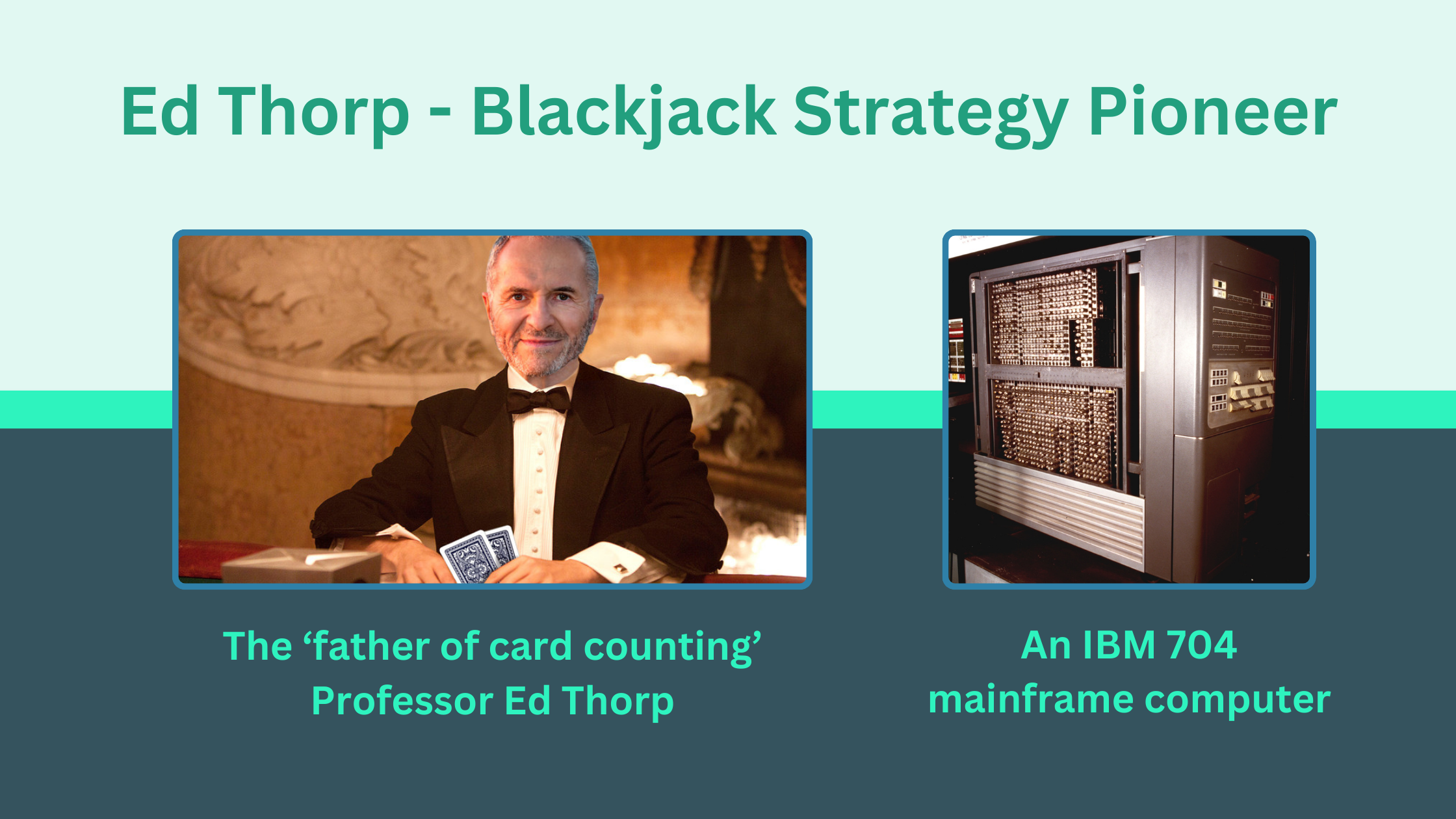
Basic Blackjack Strategy Charts
For reference, here are the Basic Blackjack Strategy charts for 4-8 decks, with separate charts for the dealer standing or hitting on soft 17.
Hard Hands
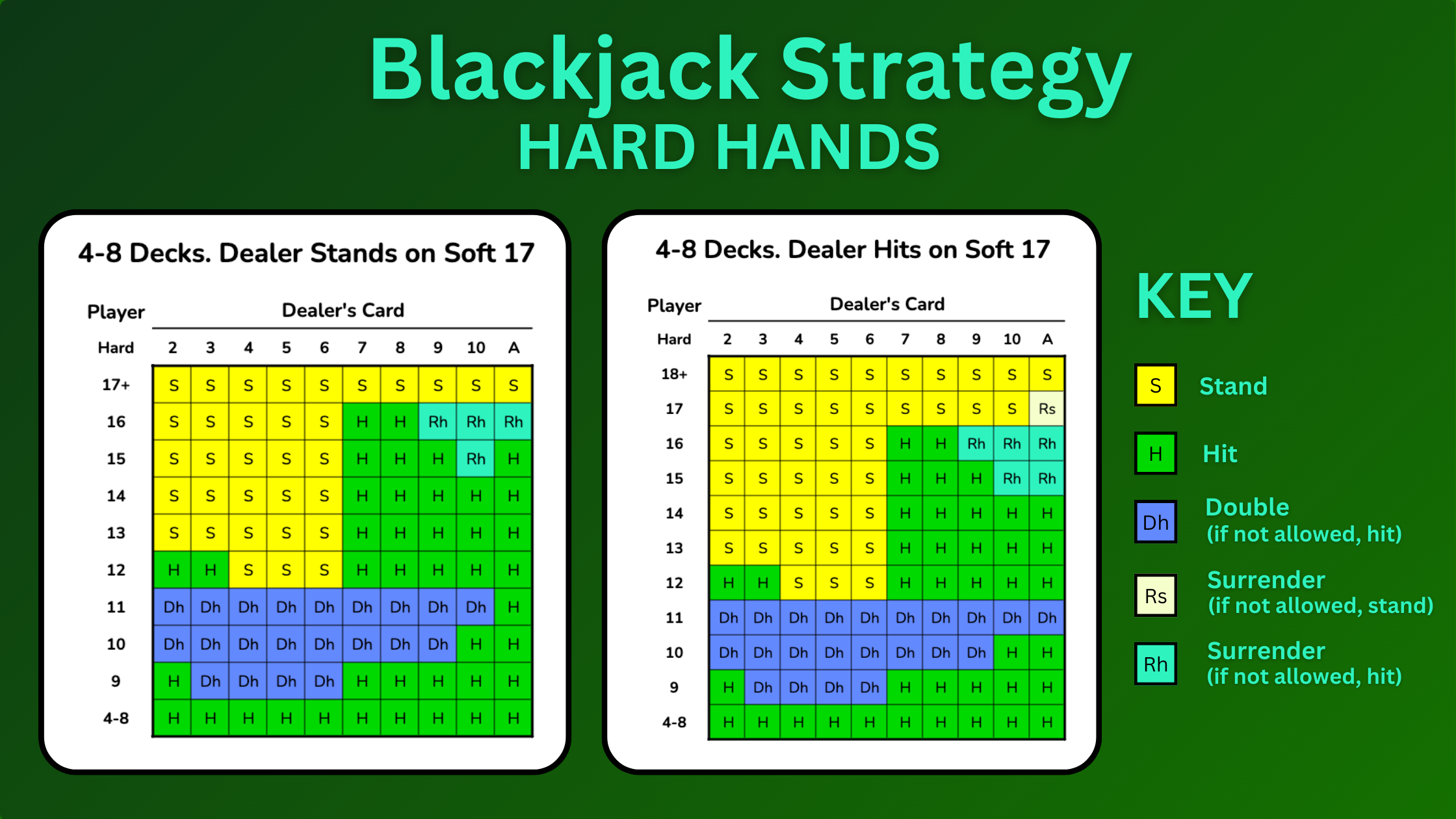
Soft Hands
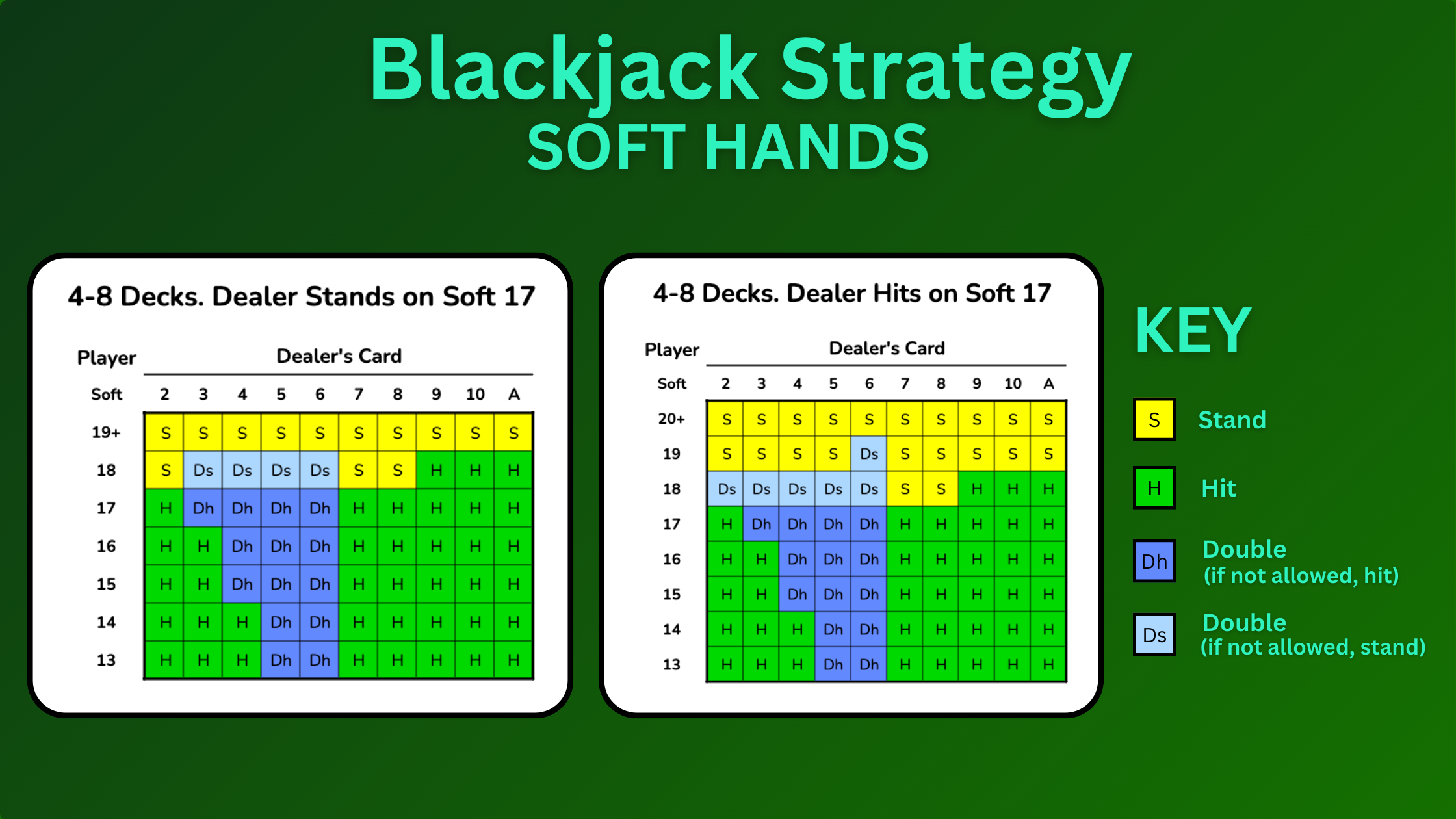
Pairs
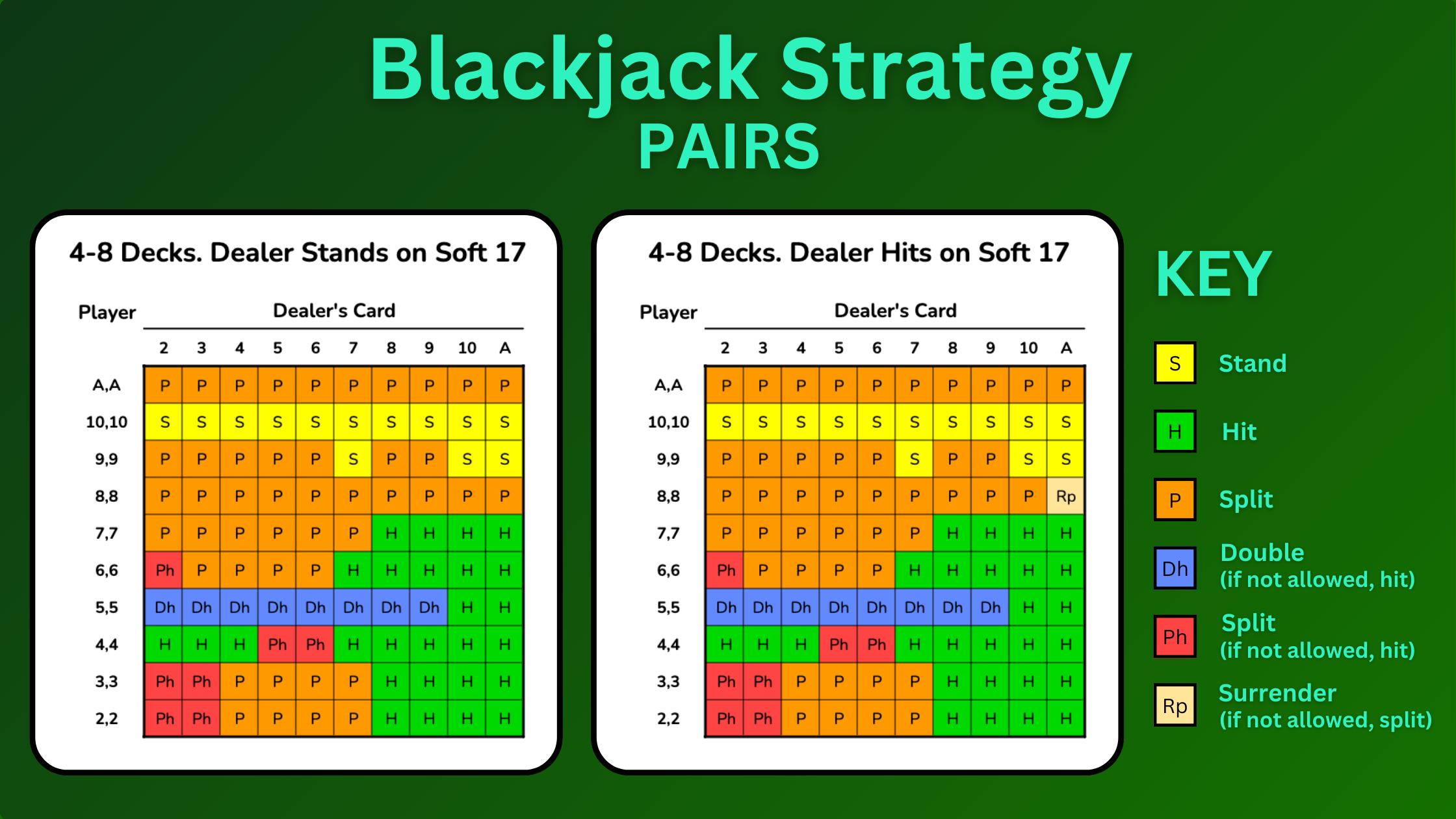
Blackjack Calculator
The good news is that there's no need to understand or learn the basic blackjack strategy. Real-world casinos will often allow you to use a blackjack strategy chart, and some will sell them. If you're playing blackjack online, Outplayed's Blackjack Strategy Calculator, which incorporates the Basic Strategy, is a fantastic tool. It tells you exactly how you should play, no matter what cards are dealt, to give you the highest possible Return To Player. To use it, you just need to enter the dealer's upcard and the two cards you're initially dealt. The calculator will let you know whether you should hit, stand, double, split or surrender.
Here's the Blackjack Strategy Calculator in action, showing a few examples of typical blackjack scenarios, all using a demo version of a popular computerised blackjack game called Premium Blackjack.
Example 1
In this game, the player has been dealt a hard 16 (a 6 and a 10) against the dealer's 9:
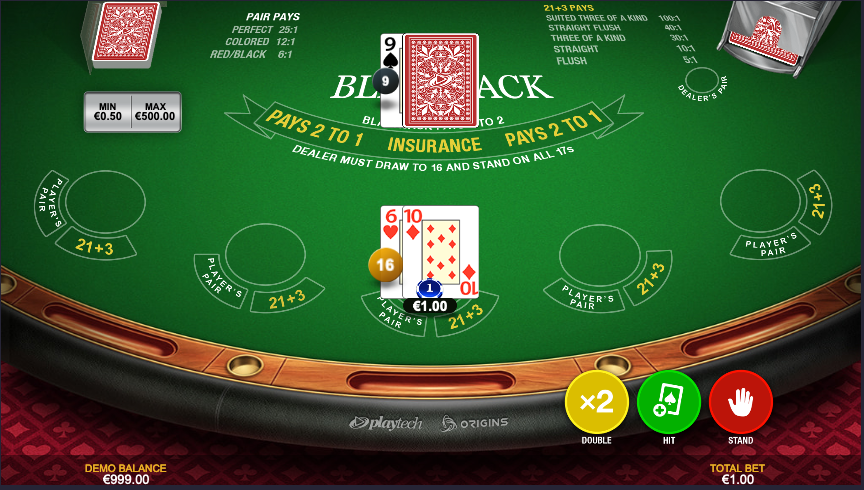
The first step is to select whether the variant of blackjack you're playing allows you to surrender, and if the dealer stands or hits on soft 17. Premium Blackjack doesn't allow surrender, and the dealer must stand on soft 17.
Then it's a simple case of clicking on the dealer's card to select what card they were dealt, and then doing the same for Card 1 and Card 2 to select your first two cards. This is what it will look like after being filled in:
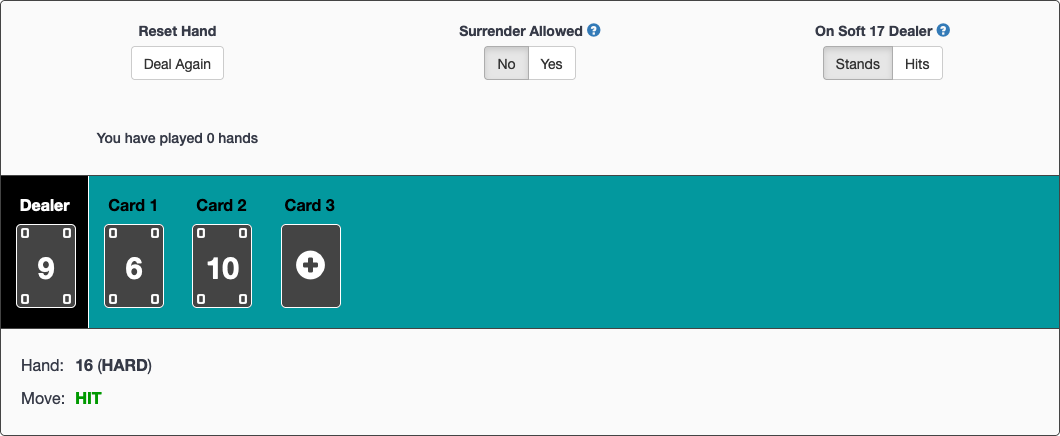
As you can see, the calculator identifies this as a hard 16 and tells you that you should hit to get another card:
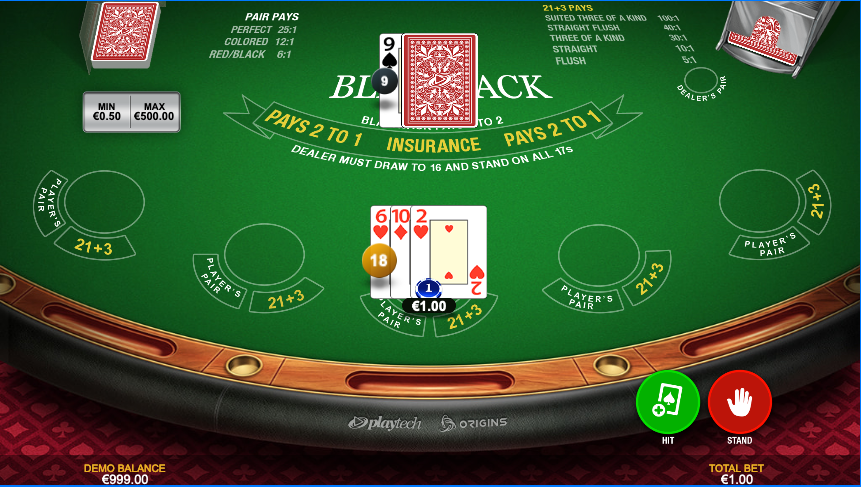
After hitting, you're dealt a 2, so your hand is still in play, and you can enter your next card by selecting Card 3:
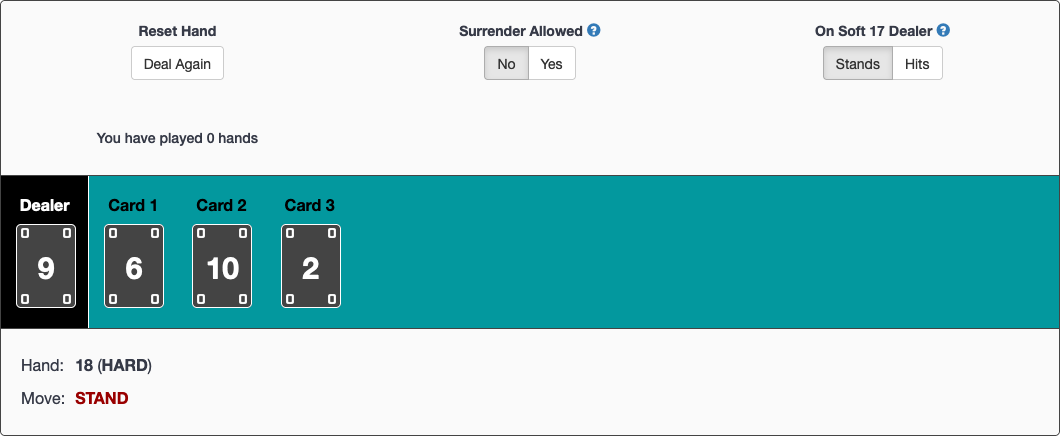
The calculator then shows that you have a hard 18 and should stand (using Basic Blackjack Strategy you should always stand on hard hands of 17 or higher).
Example 2
Soft 18 is one of the more complicated hands you can be dealt, as you can see from the blackjack strategy chart above. In this example, you've been dealt a soft 18 against the dealer's 10:

Again, you need to enter the details of the dealer's card and your two cards into the calculator:
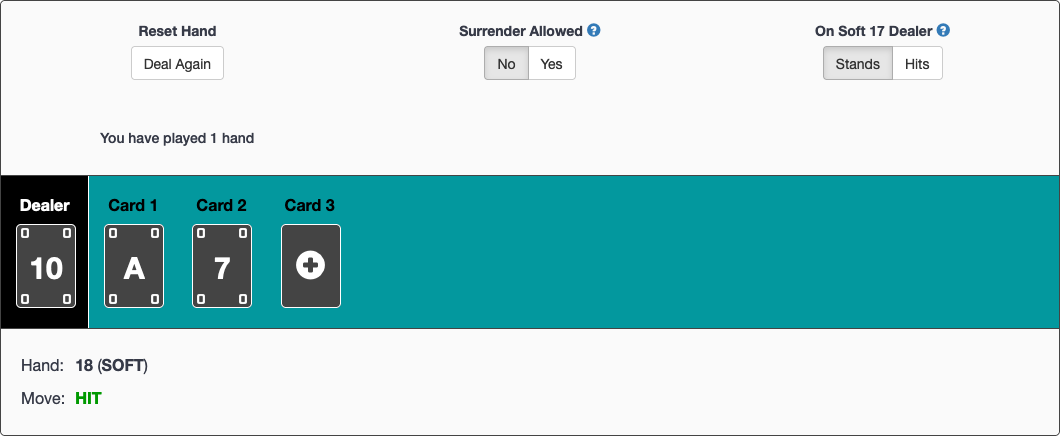
In this case, the correct strategy is to hit.
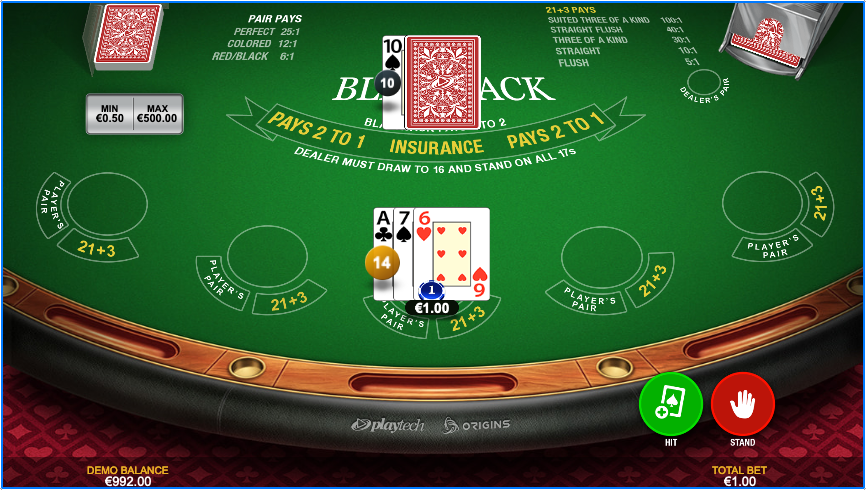
With the next card being a 6, you now have a hard 14, as you can see when this is entered into the calculator:
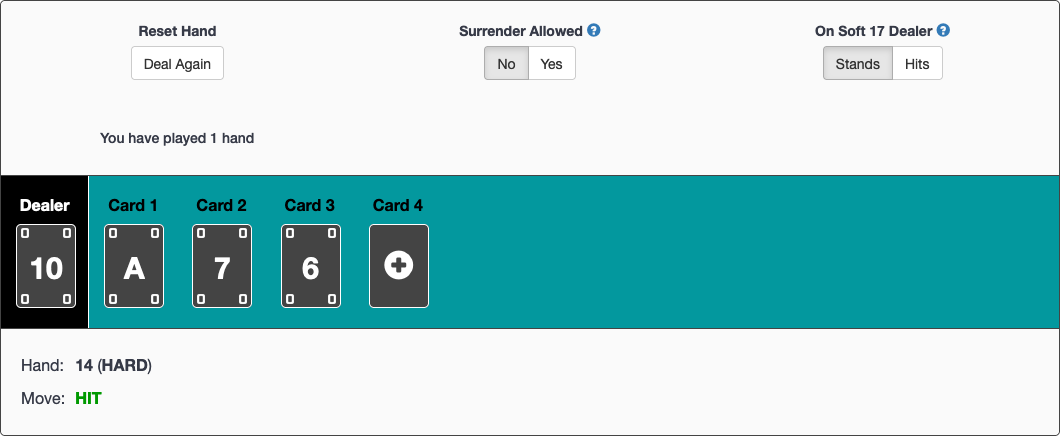
The correct strategy is now to hit again:
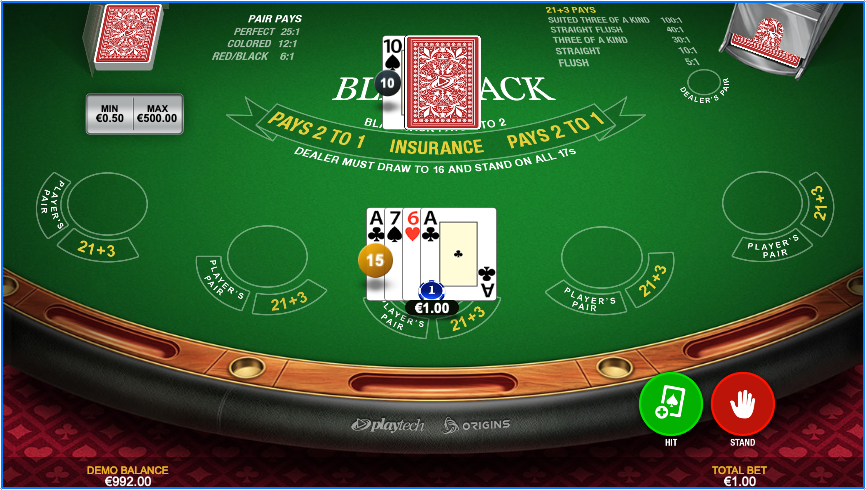
With an ace dealt, you now have a hard 15, and should hit again:
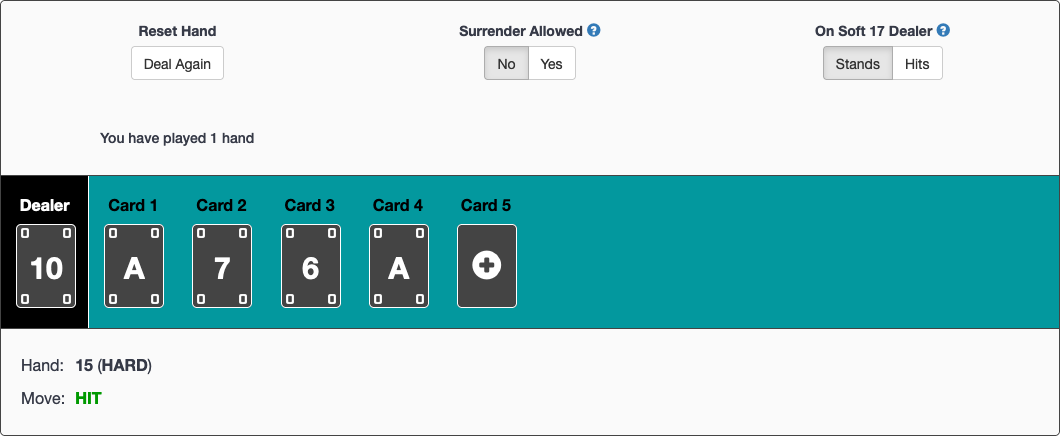
Unfortunately, the next card dealt to you is a 10-value card (a king in this case), so you bust:
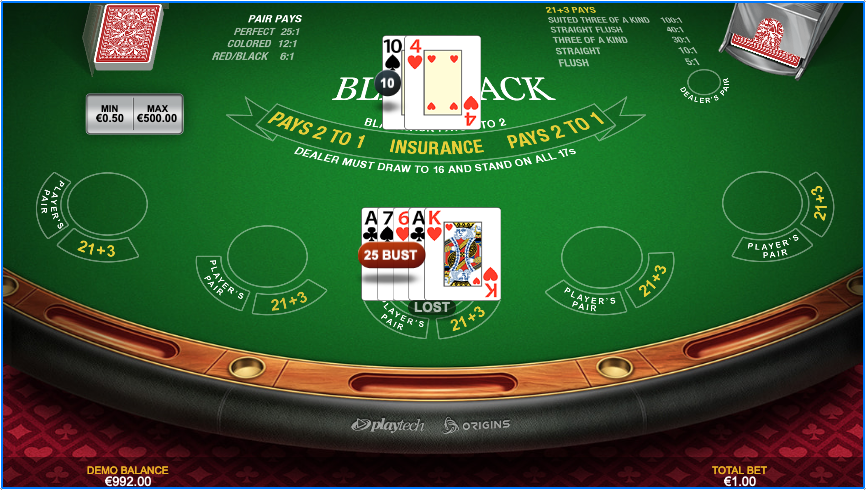
Although the hand bust, this doesn't mean that hitting was the wrong decision. The Blackjack Strategy Calculator tells you the optimum way to play blackjack to achieve the highest possible RTP (at least without card counting). However, for any given hand, there's obviously no guarantee that you'll win, even using the optimum strategy. This is due to variance and the inherent randomness of the cards you're dealt.
Example 3
This one's a simple example. You have a hard 17 straight away, and you should always stand on a hard 17 or higher, no matter what the dealer has:
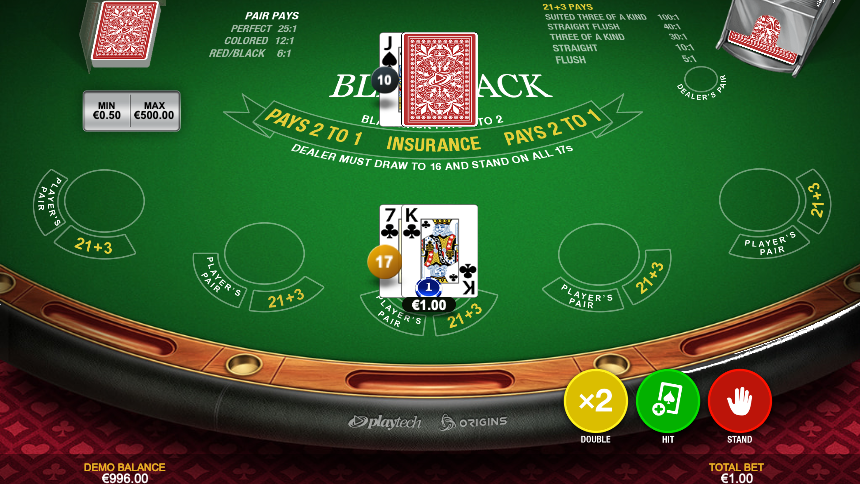
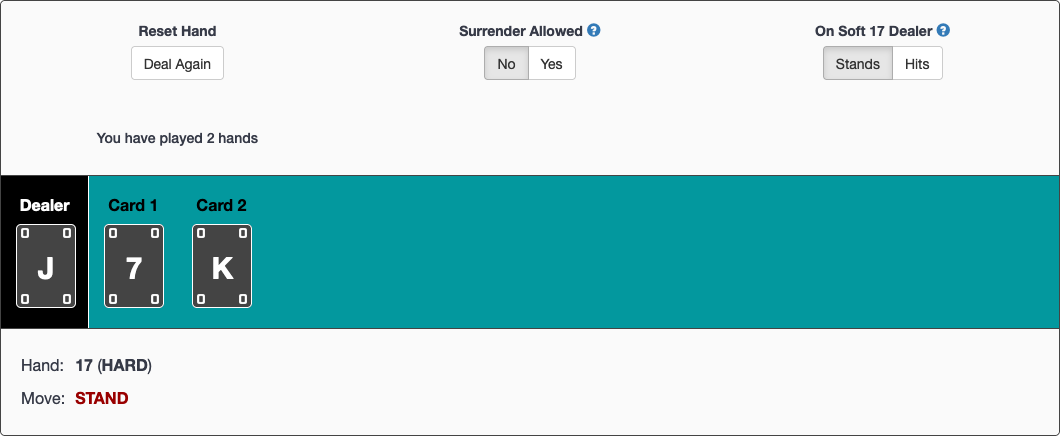
Example 4
In this example, the player at 3rd base on the left of the screenshot has been dealt a pair of 6's, and the dealer also has a 6:
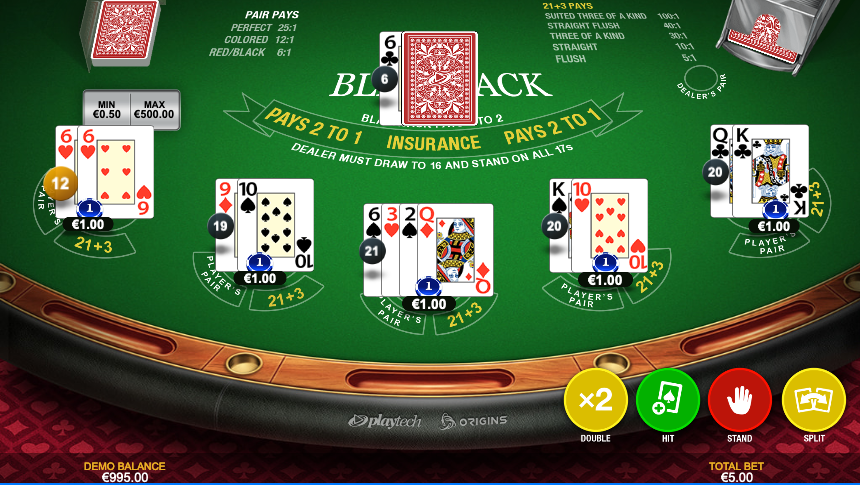
In this case, the correct strategy is to split, as you can see from the calculator:
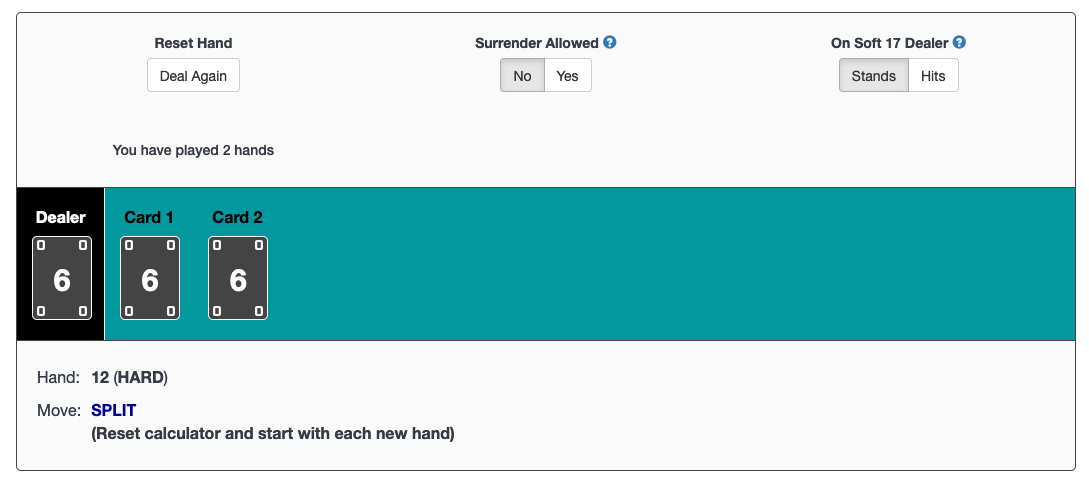
After splitting, one of the hands is dealt a king and the other a 10:
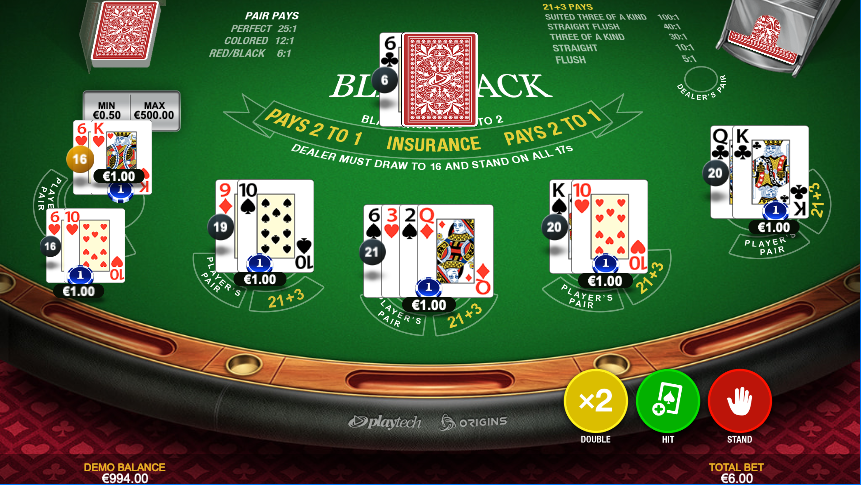
There are now two hands, so the calculator needs to be reset by selecting 'Deal Again', then entering the details of the two cards in the first of the split hands, as well as the dealer's 6:

The Blackjack Calculator shows that you should stand with a hard 16 against the dealer's 6. As it happens, the other hand is also a hard 16, so there's no need to enter this into the calculator, since all 10-value cards are treated identically, and you should stand for this hand as well.
Example 5
This example shows a pair of aces dealt to the player:

Again, you should split your hand (pairs of aces should always be split):

Again, you'll need to reset the Blackjack Calculator and use it separately for each hand. However, with Premium Blackjack, and many other variants, you only get one more card dealt if you split aces, so you wouldn't need to enter anything else into the calculator.
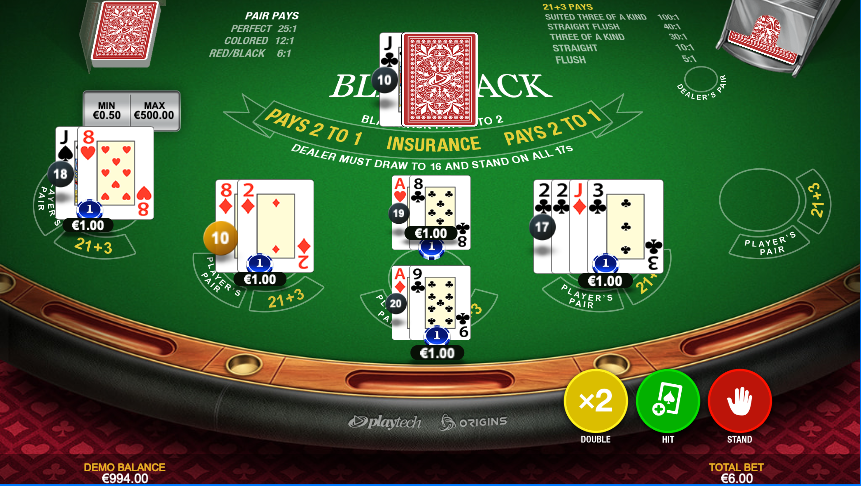
Another rule that normally affects split aces is that if you're dealt a 10-value card onto either of your aces, this only counts as 21 points, rather than blackjack, so you won't receive 1.5 times your stake if the hand beats the dealer's. It will also lose if the dealer has blackjack, and will be a push if the dealer has a total of 21 consisting of 3 or more cards:
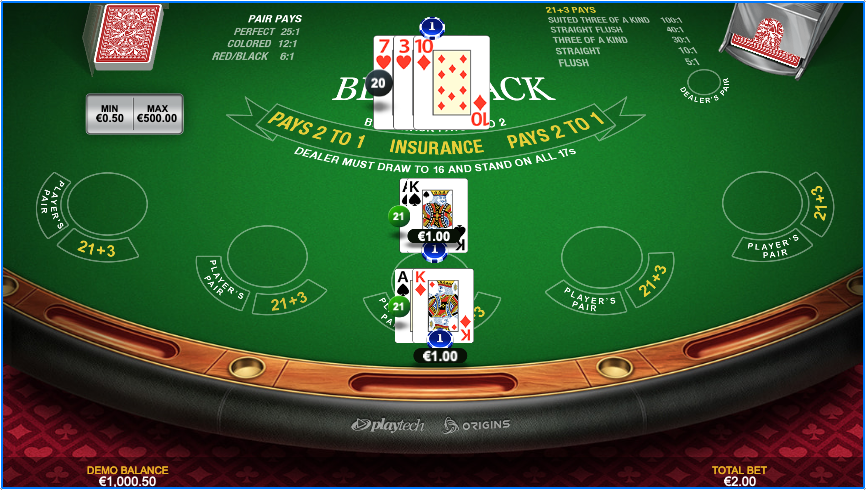
Example 6
In this final example, the player has been dealt a great hand - a 3 and an 8, giving a total score of 11, against the dealer's 8:

In this case, if you're allowed to by the rules of the blackjack variant you're playing (which you are in Premium Blackjack), you should double, to make the most of your advantageous hand. If the game doesn't allow you to double, the correct strategy is to hit instead.
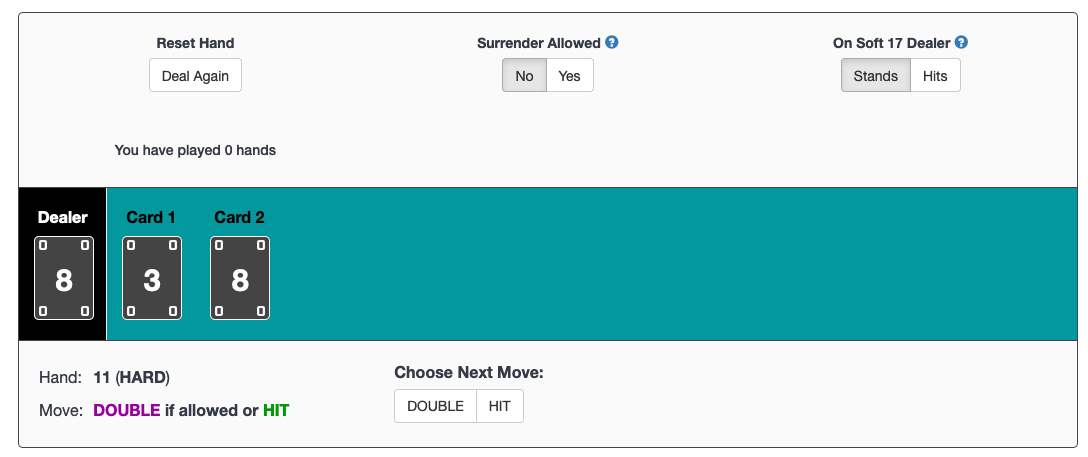
After doubling, you just receive one additional card, which is dealt sideways onto your cards. This means that there's nothing else to enter into the calculator, and you just need to hope that your hand is better than the dealer's.
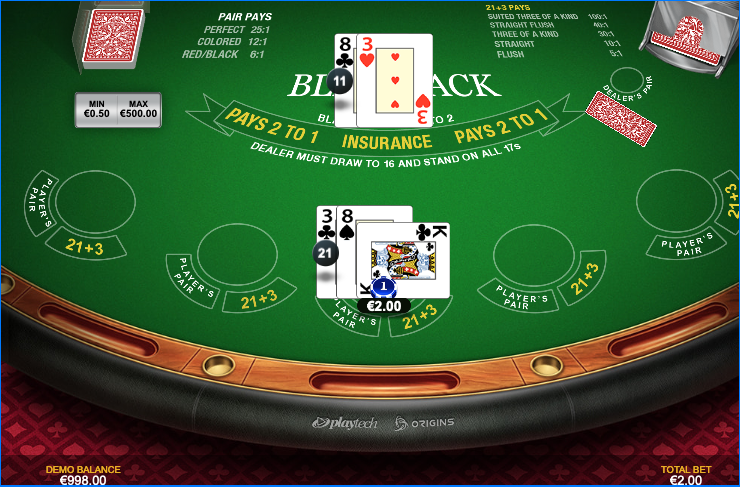
The Return to Player of Blackjack
In blackjack, Return to Player (RTP) is a measure of how much you can expect to get back, on average, over millions of hands.
One of the great advantages of blackjack, compared to most other casino games, is that it has a very high Return To Player (RTP) of around 99.5% (a house edge of 0.5%), although this varies slightly depending on the variant of blackjack you're playing. However, to achieve this RTP, it's essential to use perfect Basic Blackjack Strategy, which is why the Blackjack Calculator is so helpful for online players.
Average players, who tend to deviate from basic strategy to various degrees, will achieve lower RTPs. It's been suggested that typical players who don't stick rigidly to basic strategy only achieve an RTP of around 97% - 98% (a house edge of 2-3%), depending on how well they play. In contrast, skilled card counters have a modest edge of around 1% over the casino, which corresponds to an RTP of about 101%.
Variations in rules will have an impact on the RTP. Some of the differences can be seen in this article on the excellent 'Wizard of Odds' website, which was created by one of the foremost experts on the mathematics of casino games, Michael Shackleford:
3:2 and 6:5 Blackjack Payouts
Regular blackjack games pay 3 to 2 if you win by being dealt a blackjack, which gives a £15 profit from a £10 stake. Around the turn of the century, the Flamingo Las Vegas Casino introduced and started to promote single-deck blackjack tables. All other things being equal, single-deck blackjack has a lower house edge than multi-deck blackjack, as many casual gamblers know, which would have attracted them to the table. However, something that was much less well advertised was that these tables came with a very significant catch - they paid 6:5 rather than 3:2 for blackjack. This changes the profit on a winning blackjack from £15 for a 3:2 table to £12 for a 6:5 table - a 25% reduction.
Moving from a 3:2 payout to a 6:5 payout increases the house edge by 1.39%, from 0.5% to almost 2%, assuming all the other rules remain the same. Although moving from an 8-deck game to a single-deck game reduces the house edge by 0.48%, this is nowhere near enough to overcome the much more significant 1.39% increase introduced by moving to a 6:5 payout.
These are two of the blackjack tables available at Flamingo Casino, to illustrate how much of an impact the 6:5 rule has:
- A single-deck table with a 6:5 payout for blackjack and a house edge of 1.45% for players using basic strategy.
- An 8-deck with a 3:2 payout for blackjack and a house edge of 0.56% for players using basic strategy.
As you can see, a gambler on the single deck table will lose money almost three times as much quickly as a player on the 8-deck table, if the games are played as quickly on each!
Since their introduction, there's been a significant increase in the number of 6:5 tables. This has been driven by a desire by casinos to increase their profits, alongside a regular flow of casual gamblers playing on them despite their poor value.
The solution is simple - never play blackjack at a table that pays 6 to 5 on blackjack! Blackjack should always be paid out at 3:2. If you see a table like the one below (and this one's even worse because the dealer hits on soft 17), walk away!

Can You Make a Profit Playing Blackjack?
Even if you play perfect Basic Blackjack Strategy to the letter, either by using charts, memorising the strategy, or using a blackjack calculator, the best you'll do is minimise your losses by reducing the house edge as much as possible and maximising your RTP. The casino will still have around a 0.5% edge over you. So with that in mind, are there any ways you can actually make a profit from playing blackjack? The good news is that there are!
There are basically a couple of ways to gain an edge over the casino when playing blackjack. The first of these is to attempt to overcome the house edge by using advanced advantage gambling strategies like card counting, hole carding, shuffle tracking, and edge sorting. These all take great skill, practice, and experience, but if done well, they can give you a long-term edge over a casino, similar to how the much more straightforward sports value betting gives you a long-term edge over a bookmaker.
The second and far easier method is to use blackjack when completing positive EV casino offers. We'll look at this first.
Playing Blackjack With Casino Offers
By far the easiest way to profit from playing blackjack is to use it for worthwhile casino offers that have a positive expected value. If you're allowed to use blackjack, this is often the best way to maximise the value of the offer.
Here's an example of part of an offer write-up for a casino sign-up offer on Outplayed.com:
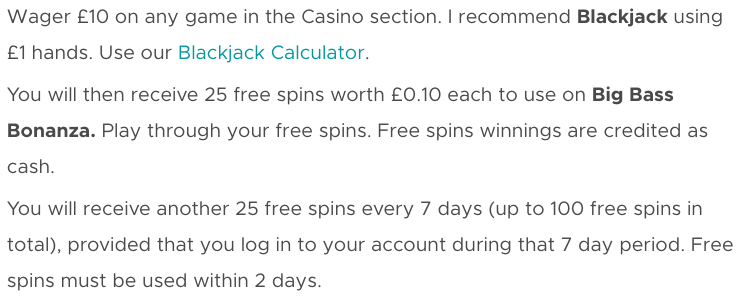
Blackjack is the best option here due to its very high RTP of around 99.5%. Using the Outplayed EV Calculator, you can see that this offer has an excellent Expected Value of almost £10 when using blackjack for the initial wagering:
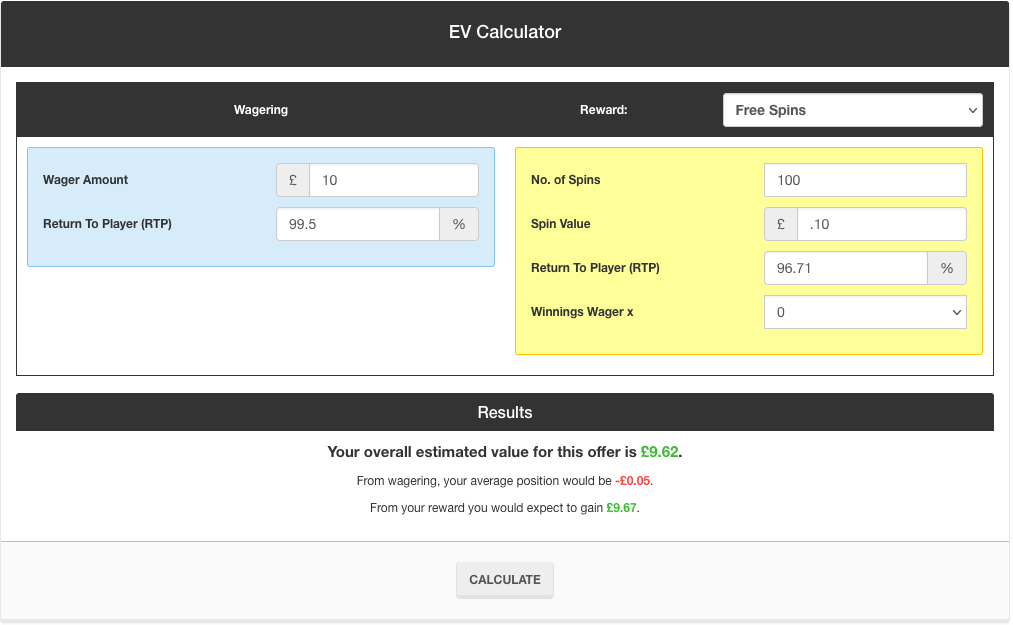
If you were to instead use a slot, which has a typical RTP of around 97%, your expected value would drop from £9.62 to £9.37. Although it's only a small amount for one offer, it really adds up over time, which is why blackjack is such a good choice for offers, if the terms of the offer allow you to use it.
Card Counting
Card Counting is by far the most well-known advantage play strategy used to try to gain an edge over the house in blackjack. It was the subject of Ben Mezrich's 2003 book 'Bringing Down the House', which was later adapted into the film '21'.
Several different card counting systems exist, but a common feature is that they all aim to track the cards that have already been played in some way, then use this information to make decisions about how to play. Although this will only be a relatively brief overview of card counting, there are several books on the subject. Information can also be found online, including websites dedicated to card counting, like Blackjack Apprenticeship.
It's important to point out that card counting is completely legal - there isn't a law against using your brain to gain an advantage! However, most casinos reserve the right to ban players who they suspect of card counting.
With roulette and slots, each event is independent of each other, whereas in blackjack, events are affected by previous events. If more low cards than high cards are dealt, for example, this means that the deck is more favourable to a player, since high cards are good for the player.
Before even considering starting card counting, it's essential to master Basic Blackjack Strategy, so that you can effortlessly apply this to your play, no matter what you and the dealer are dealt. This involves memorising the whole strategy, which can take a few weeks of committed practice.
One of the most popular methods of counting cards is to use the Hi-Lo System, which can be used for any number of decks. The system involves keeping a running count, which tracks the type of cards that have already been dealt. The system can be broken down into the following stages:
- Each card is assigned a value. Low cards (2-6) have a value of +1. High cards (10-value cards and aces) have a value of -1. The remaining cards are Neutral cards (7-9), and have a value of 0.
- As cards are dealt, you keep a running count (starting from zero) in your head from the first card drawn from the shoe to the last, including both the dealer's and all the players' cards. If you see a low card, you add 1 to the count and if you see a high card, you subtract 1 from the count. Neutral cards do not affect the count. Thinking of a positive count of +2 as 2 and a negative count of -3 as D3 (down 3), for example, can make it easier to keep track, since it’s quicker to 'say' them in your head.
- Calculate the count per deck (true count). To do this, divide the running count by the number of decks not dealt yet. This can be judged by looking at the space in the discard tray to judge how many decks remain. You also need to know how many decks there are in play in total. The true count is rounded down to the nearest whole number.
- Use the true count to decide how to bet, how much to stake, and when to use deviations from Basic Blackjack Strategy. Card counting teams have a 'spotter' at the table, playing the table minimum stake whilst keeping track of the count. When the count is sufficiently high, a discreet signal is made to call in a 'big player'.
- This player then joins the table (known as 'Wonging in', after the prominent card counter Stanford Wong, who popularised the technique). The big player starts betting with much larger stakes, up to the table maximum, which maximises the value whilst the table is 'hot' (i.e. when the count is high).
Contrary to how card counting is often portrayed in films, with the card counters seemingly winning most of the time, the reality is a little less glamorous.
Since card counting only gives you a relatively small edge of around 1% over the casino, and due to the variance inherent in blackjack, you'll often lose your hand when card counting, even if the count is very favourable to you. Card counters tend to make a profit on around 55% of sessions and a loss on the other 45%.
Other factors to consider when card counting are the possibility of backoffs, where a casino asks you to leave if you're winning too much, or they suspect you of card counting. Ensuring that the stakes you use are appropriate to your bankroll is also vital.
Card counting is generally considered to only be effective in real-world casinos. Even then, it's difficult to become good enough to use it to make long-term profits. It doesn't work at all with computerised blackjack games, since the cards are shuffled before every deal. With online blackjack using actual dealers it is also generally thought to be not worth doing, as discussed here.
Summary
Blackjack is a hugely popular game that is played across the world, both in real-world and online casinos.
Although it's a skill-based game, it's unusual in that there is a 'right' way to play it, by using Basic Blackjack Strategy to minimise your losses when gambling recreationally on blackjack.
However, it's possible to give yourself the edge over casinos by taking advantage of casino offers or, for highly committed individuals, turning your hand to card counting.
You can find out more about using blackjack to take advantage of casino offers, or learning how to profit from bookmaker sports offers with step-by-step guides by going to Outplayed.com.
Updated: 27 Dec 2024
The Author
Simon has helped thousands of members profit from Matched Betting using both his passion for writing and desire to understand how things work. He has used his mathematical and analytical skills to create several guides, calculators, betting and casino tools to make the process of Matched Betting easier for newcomers and experienced members alike.

